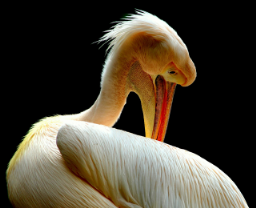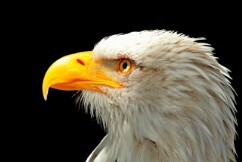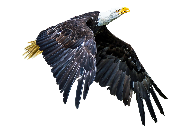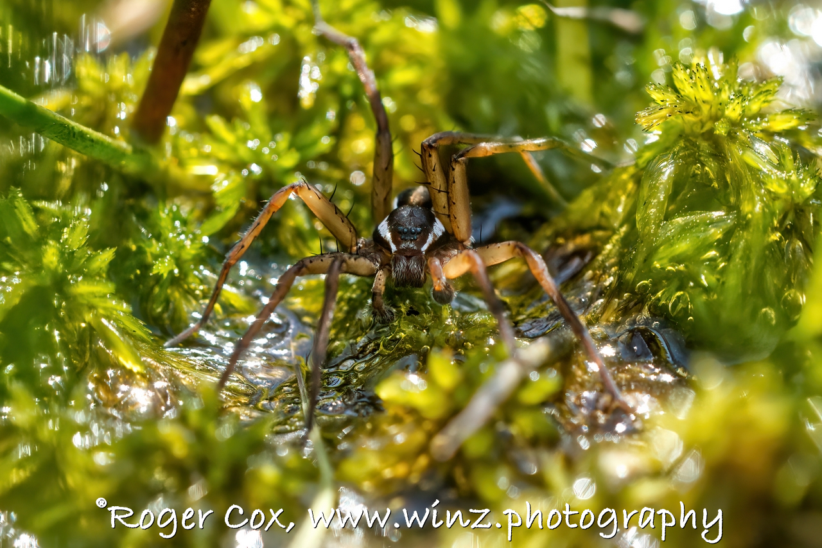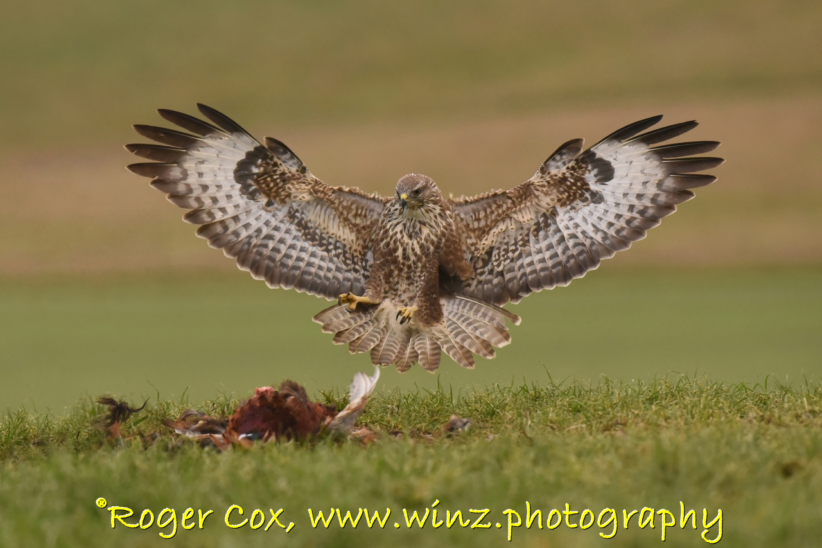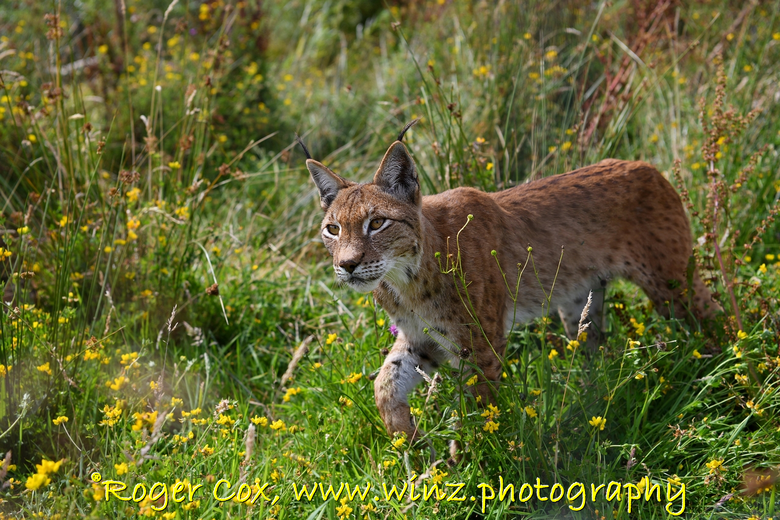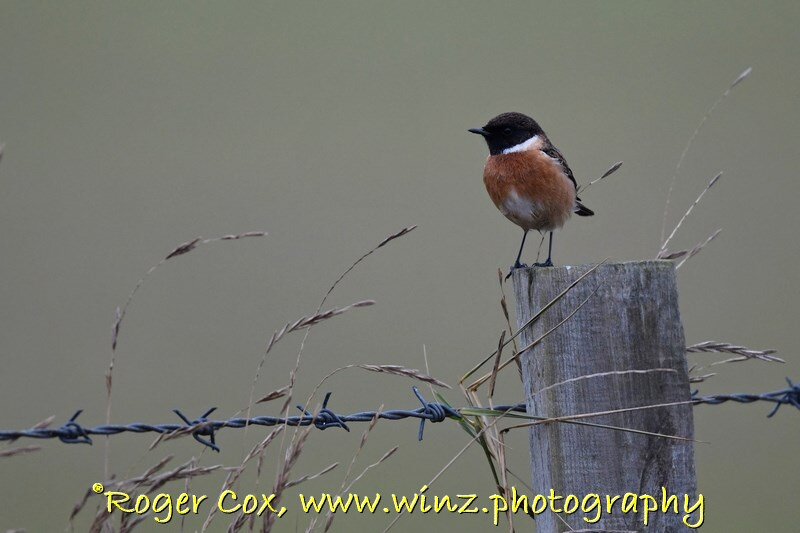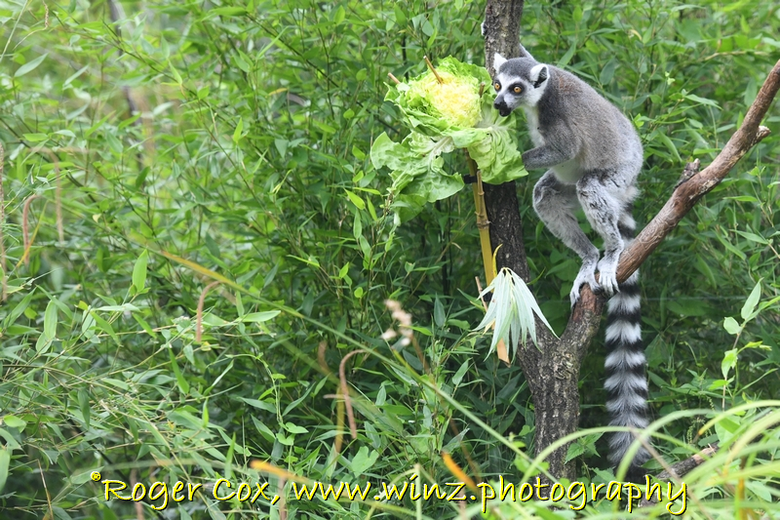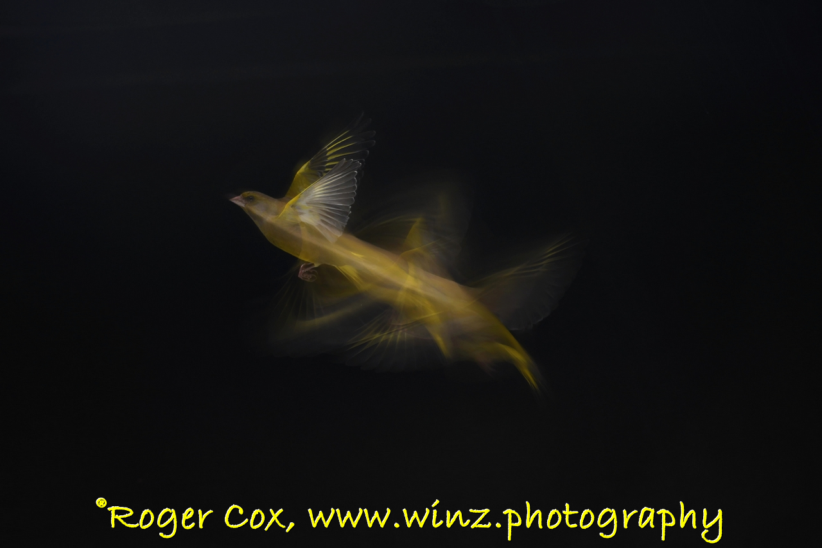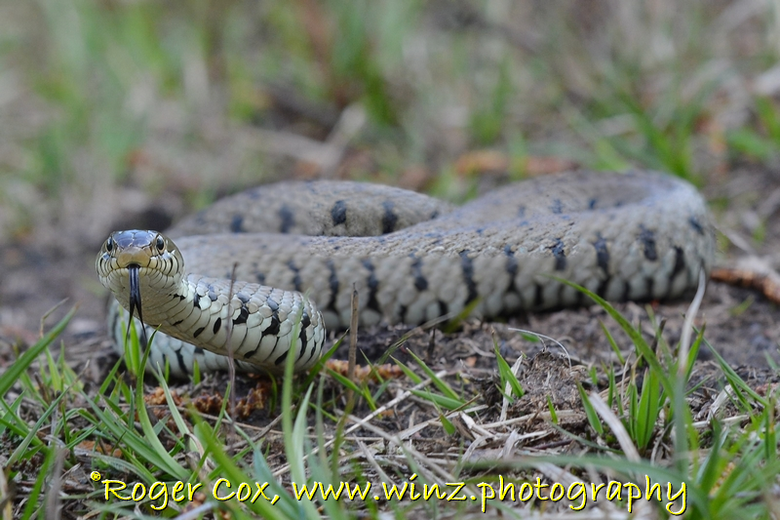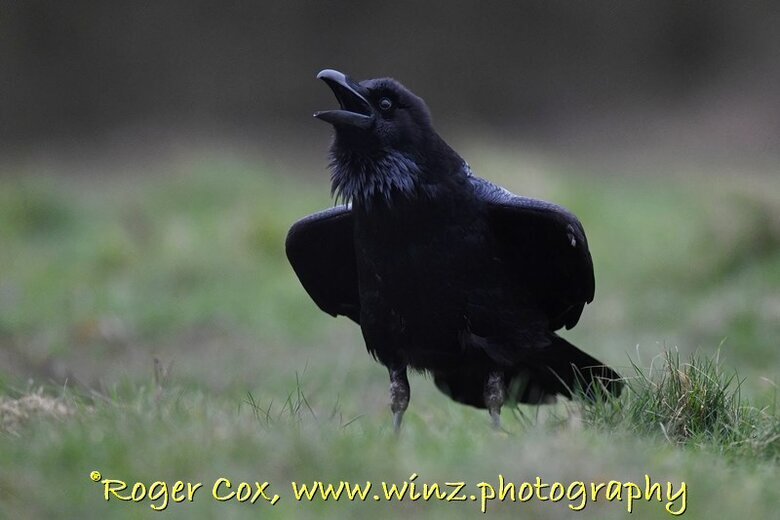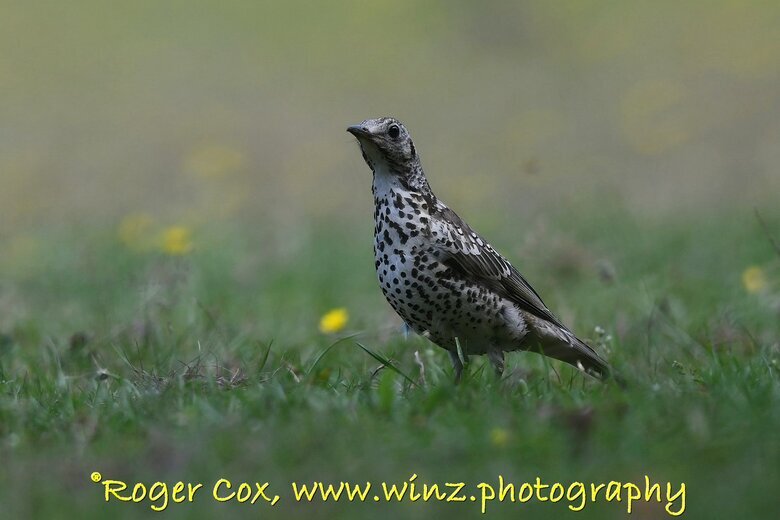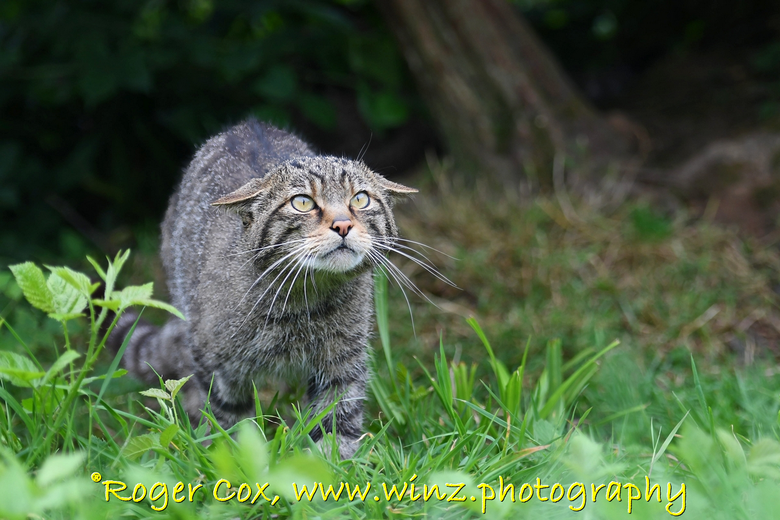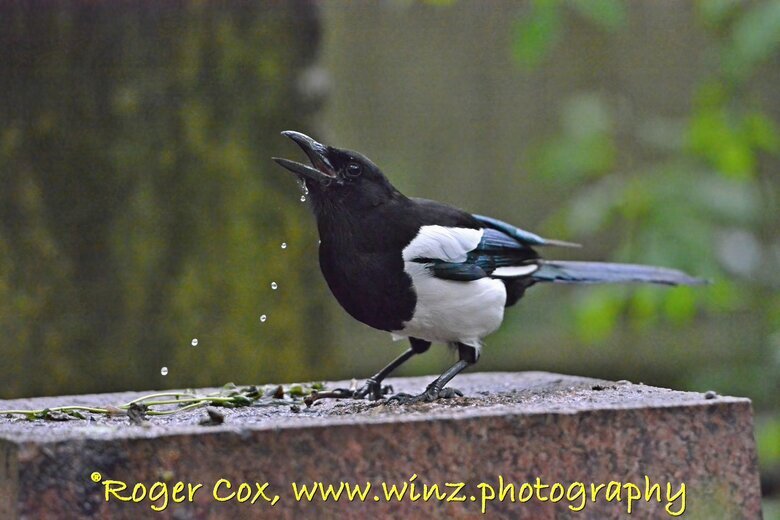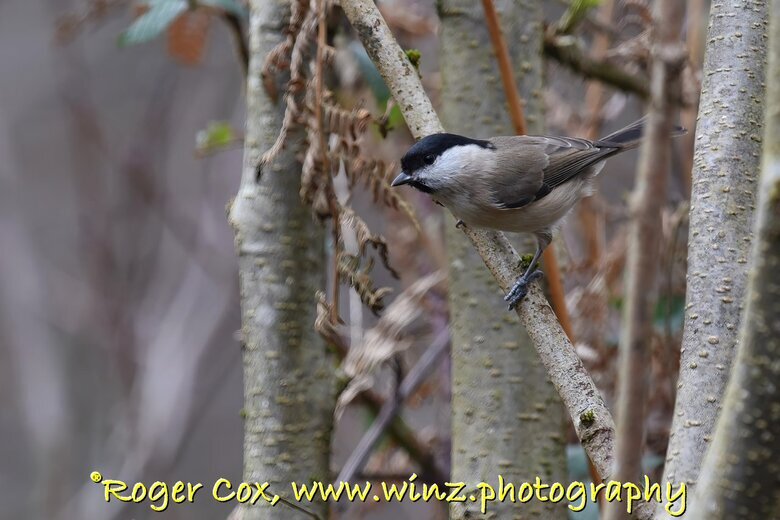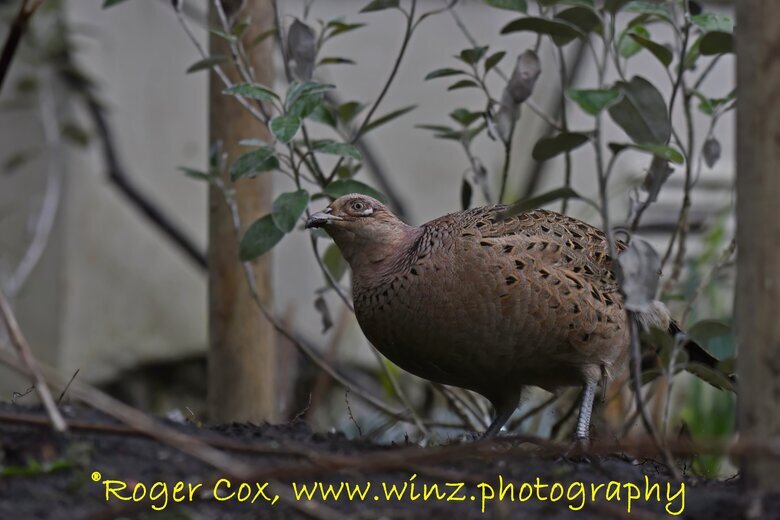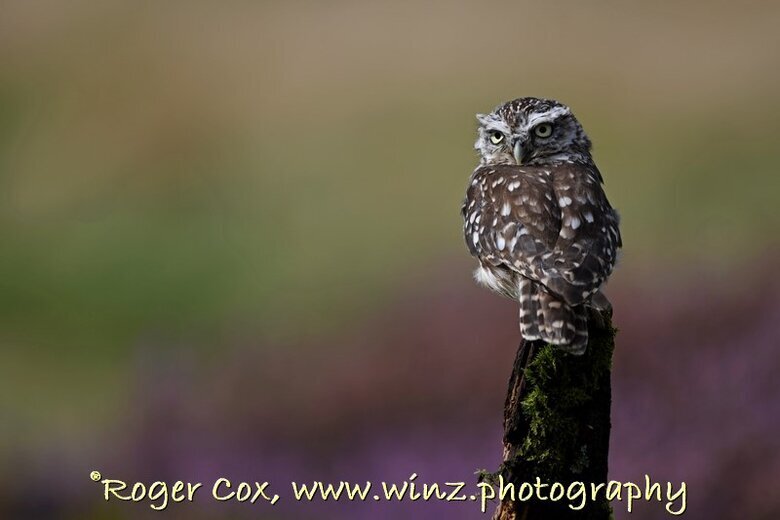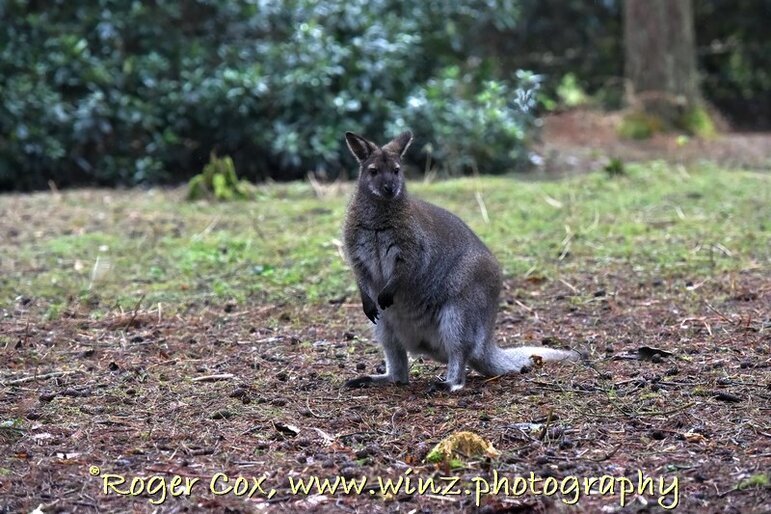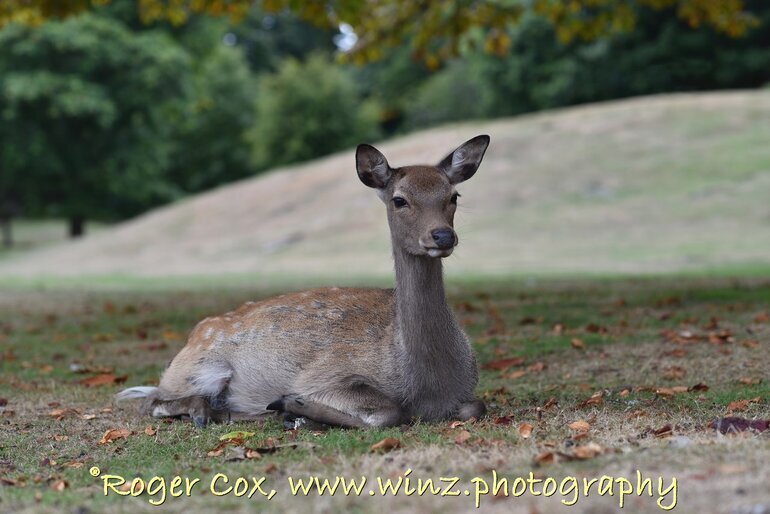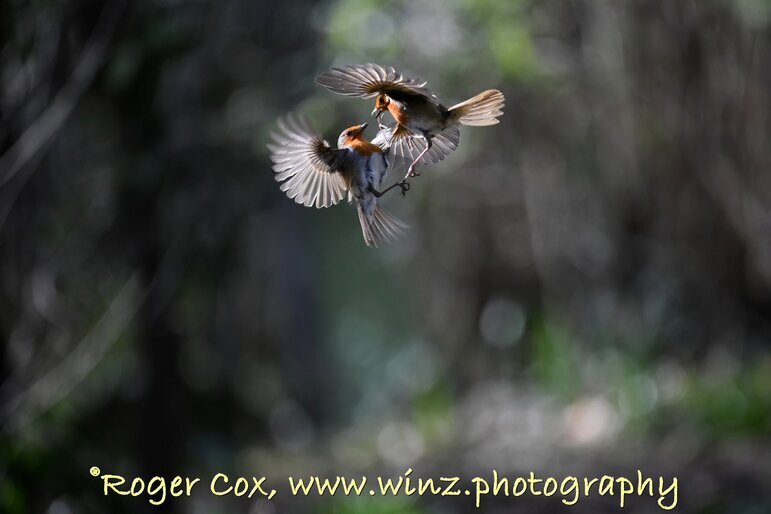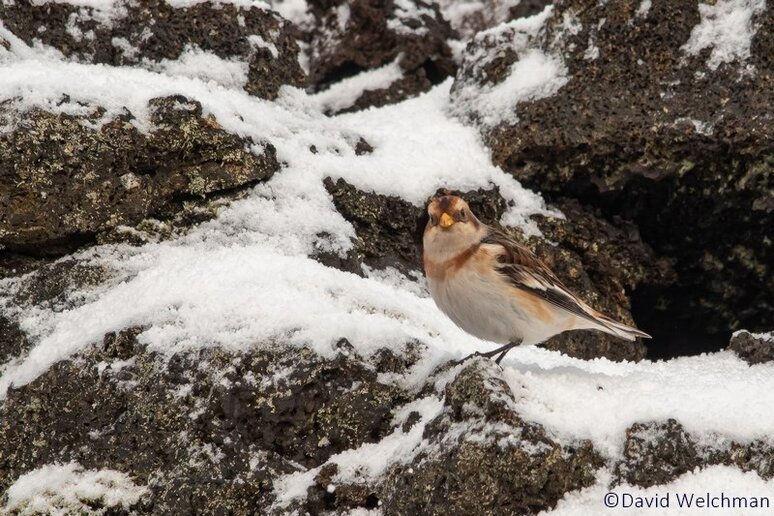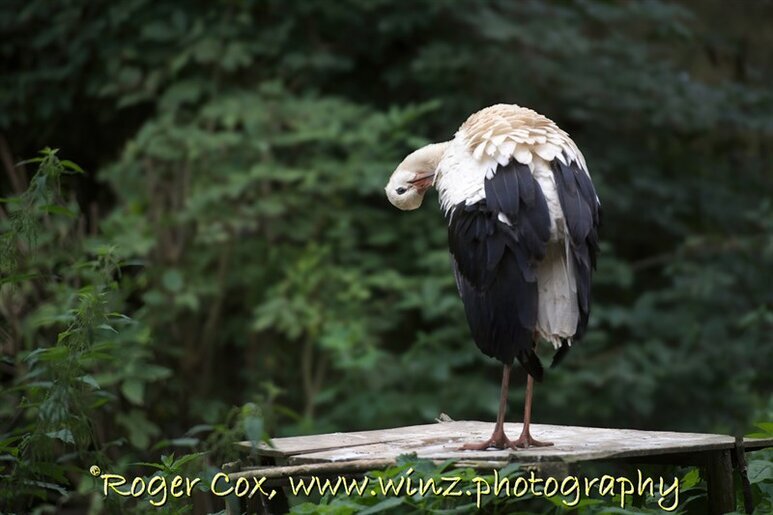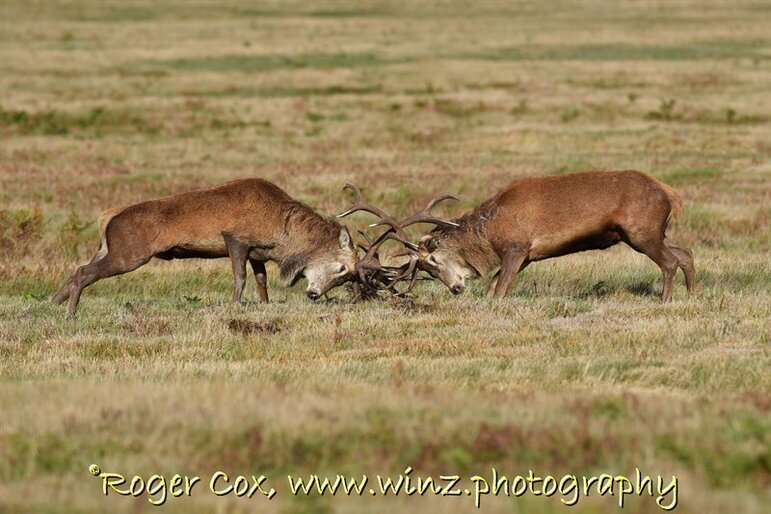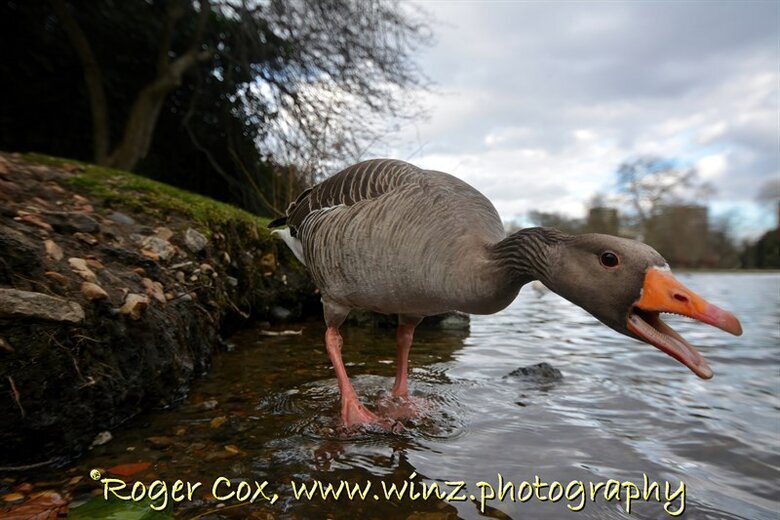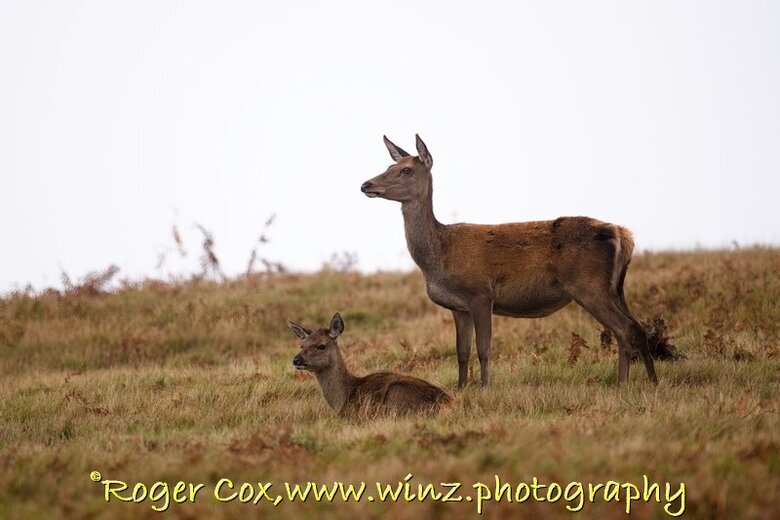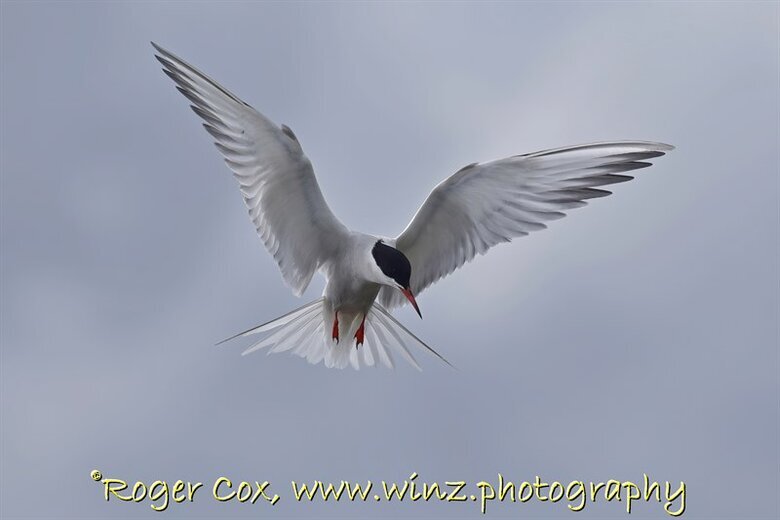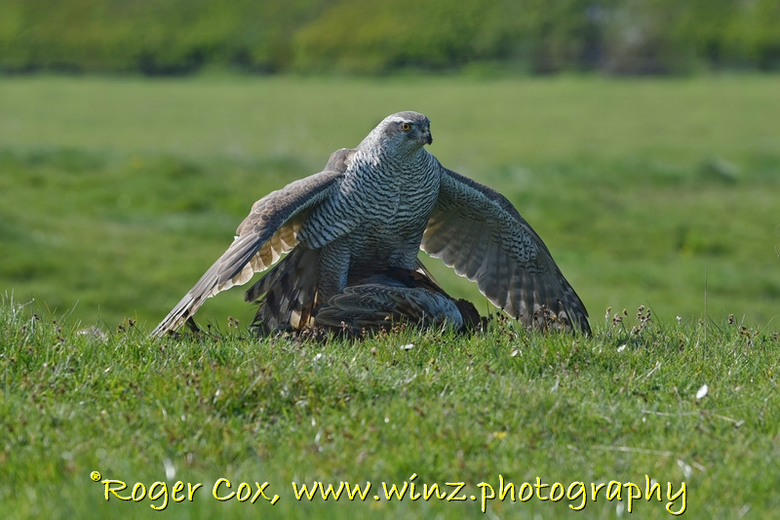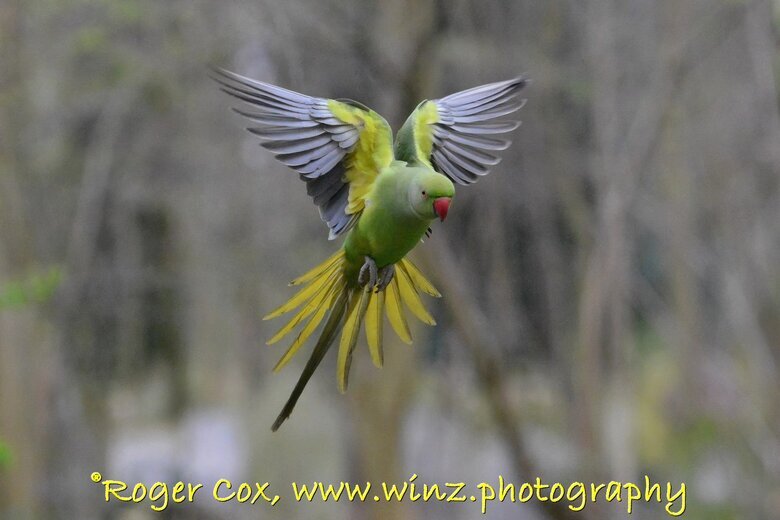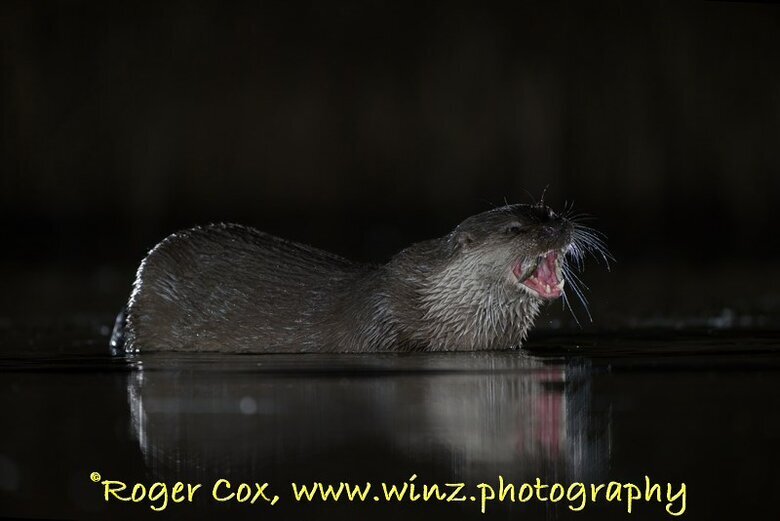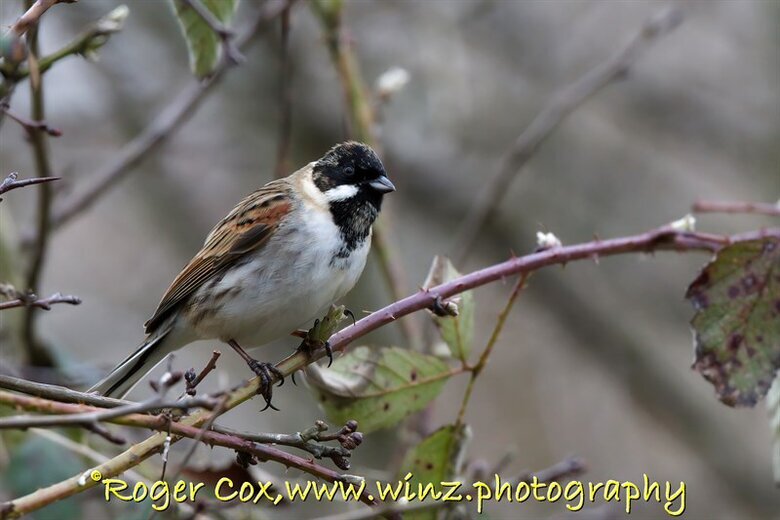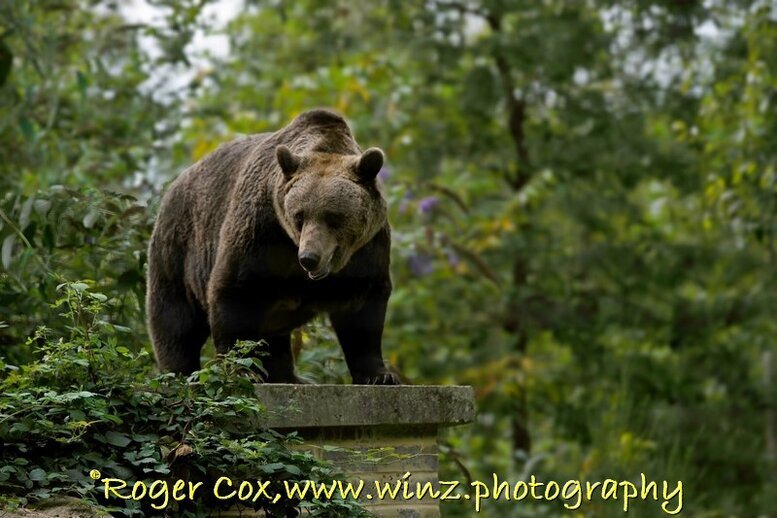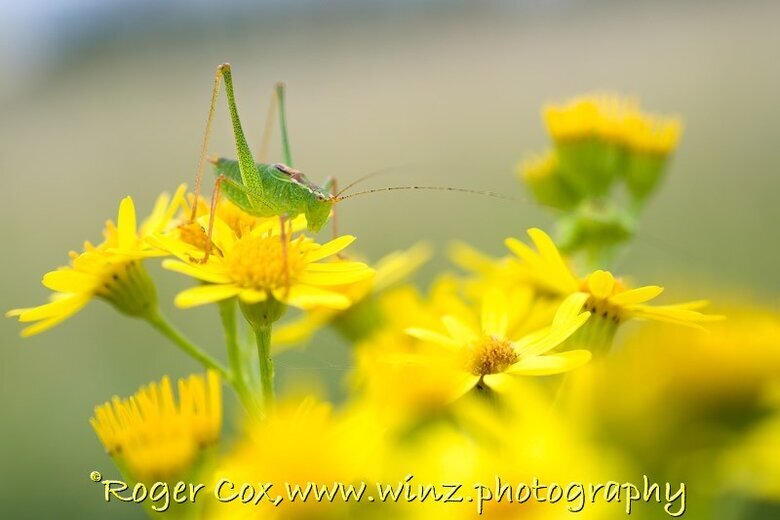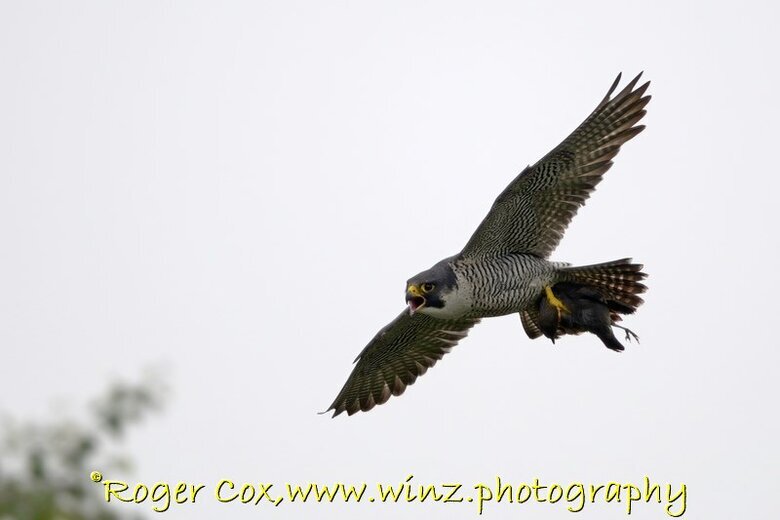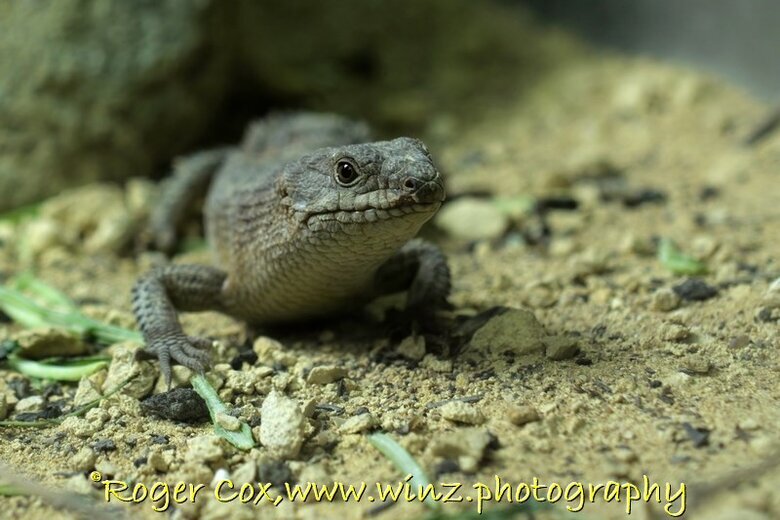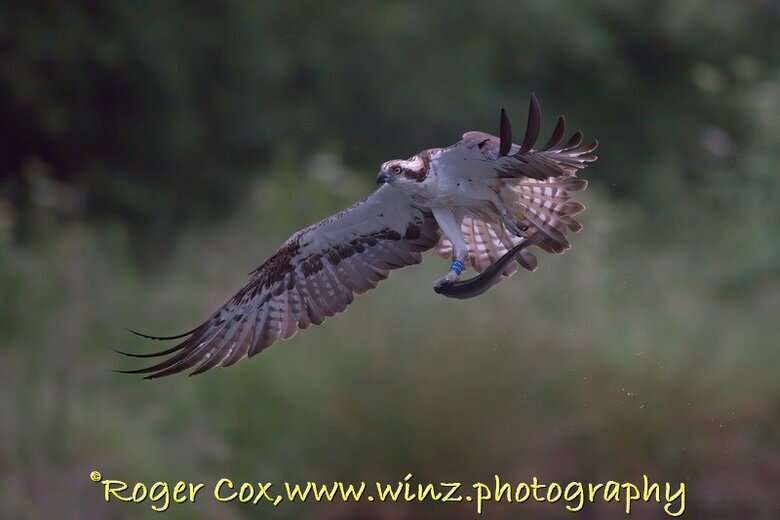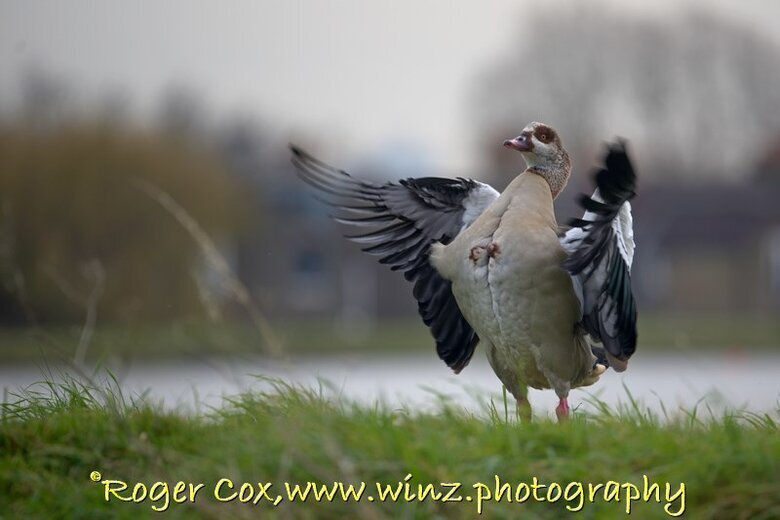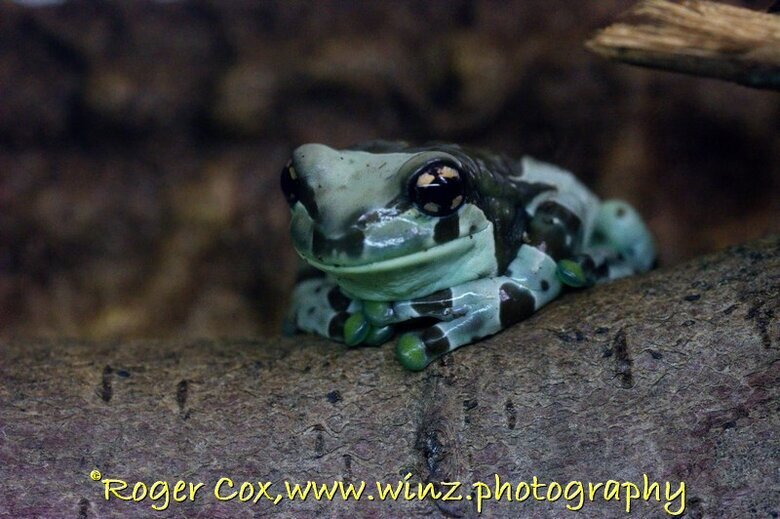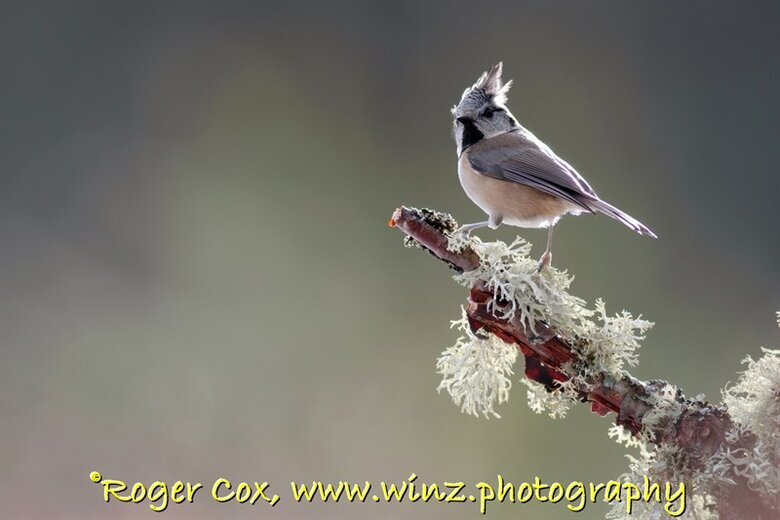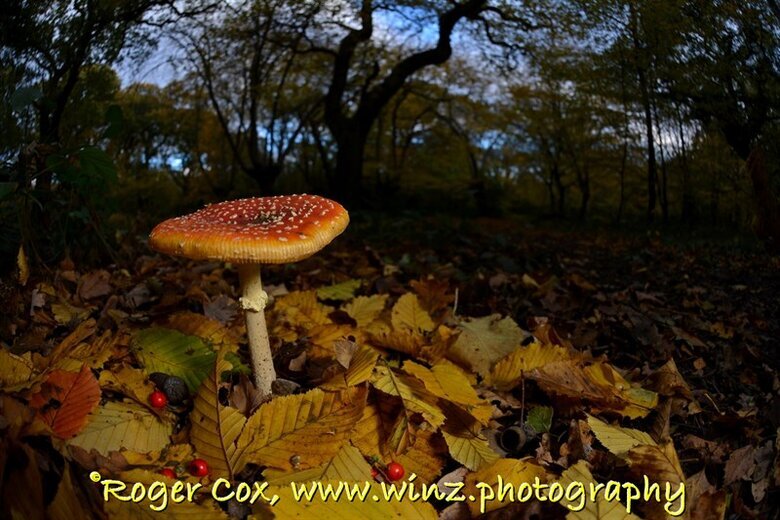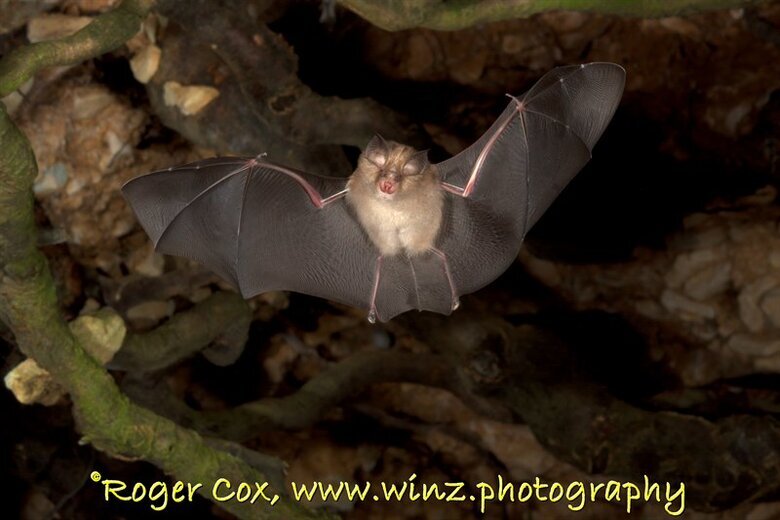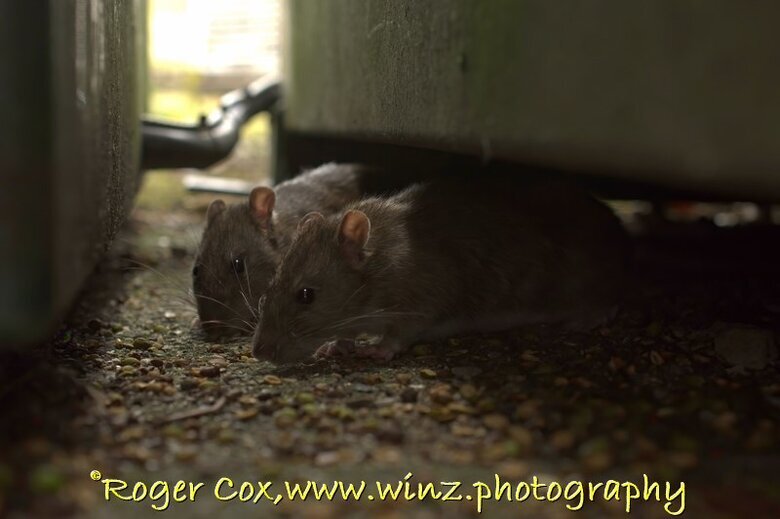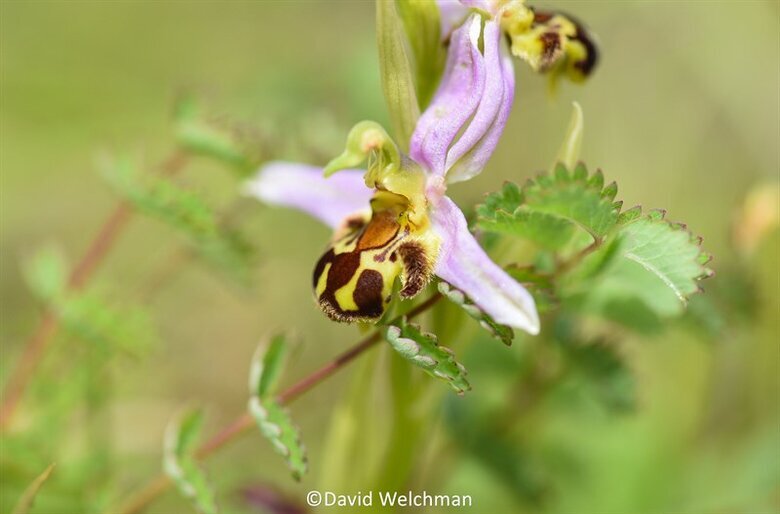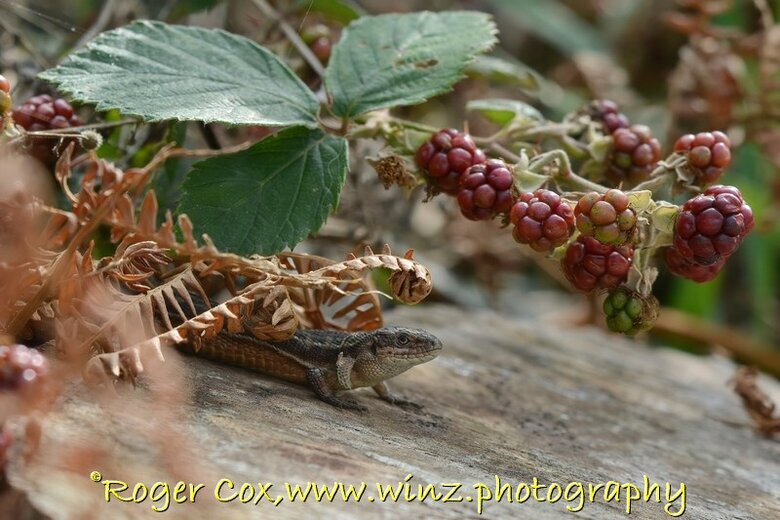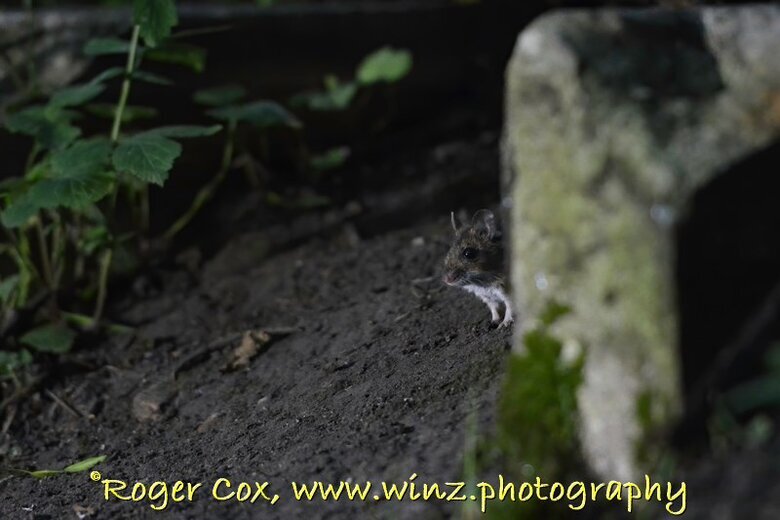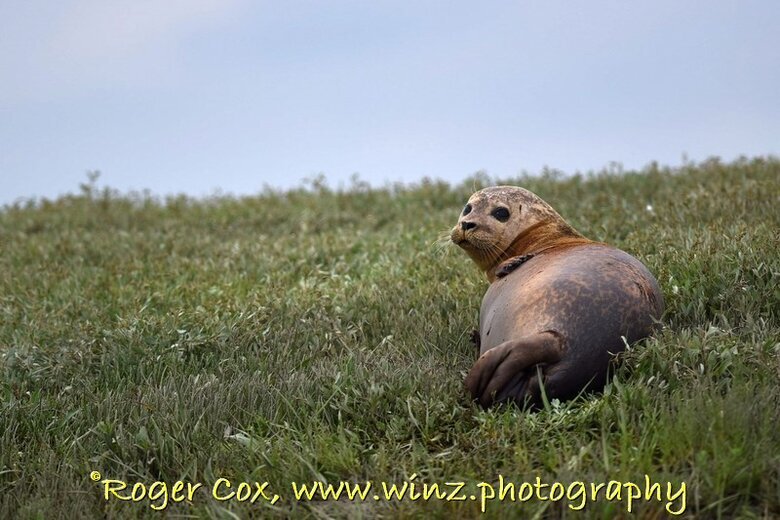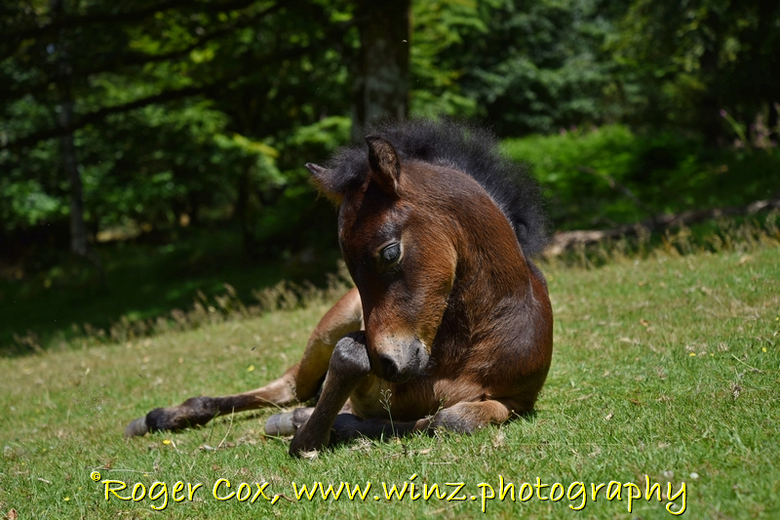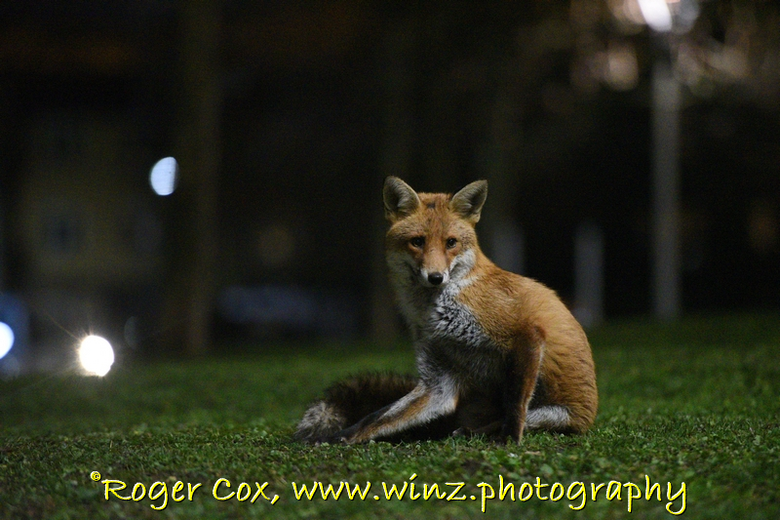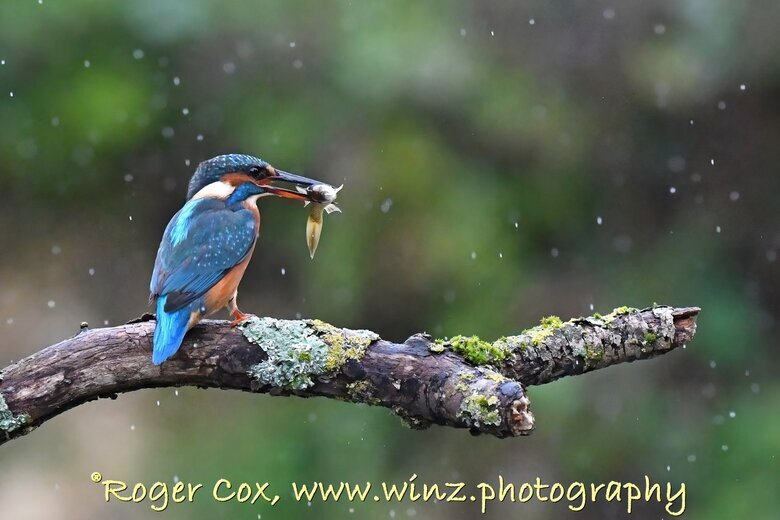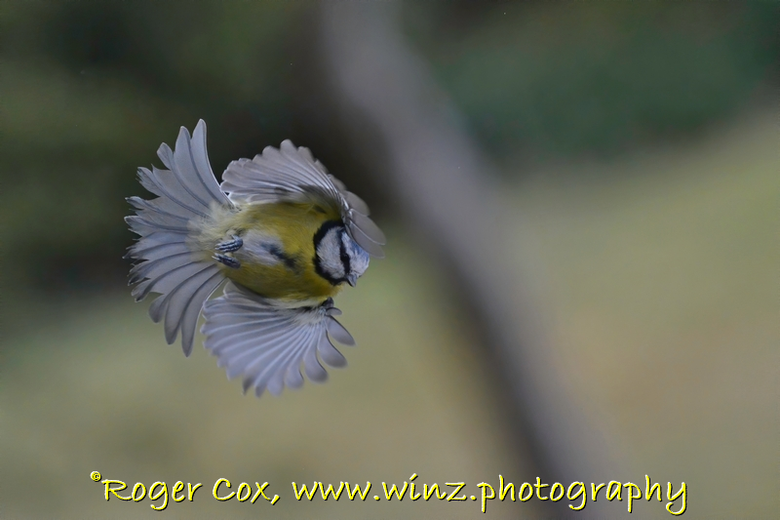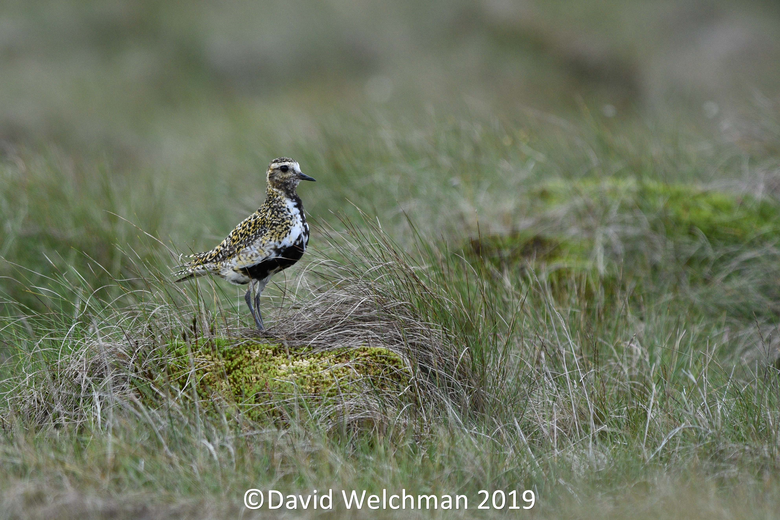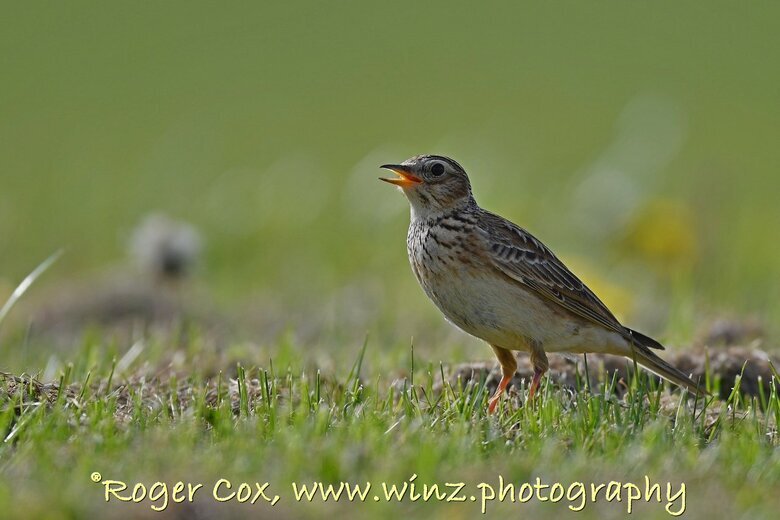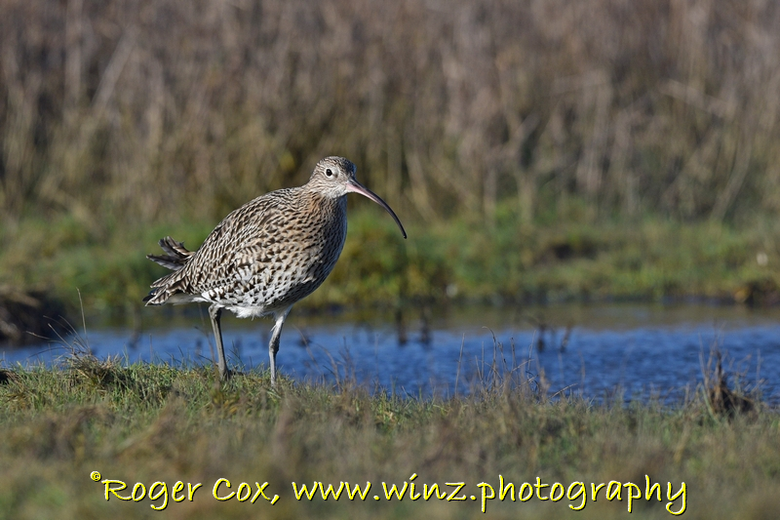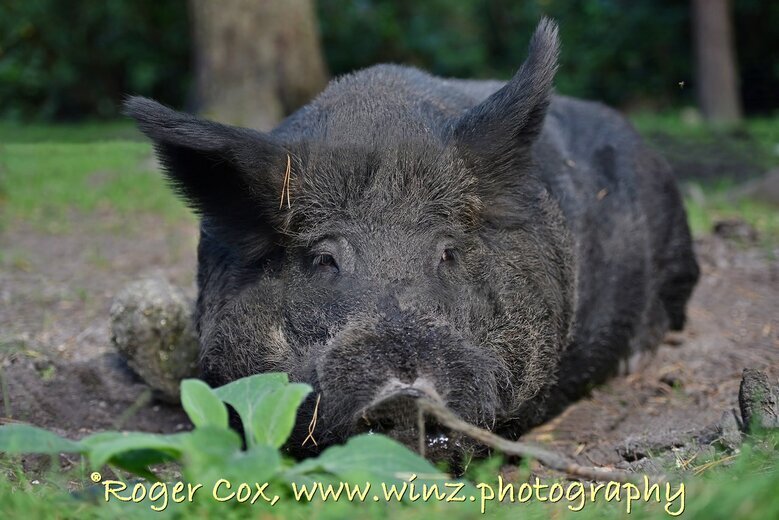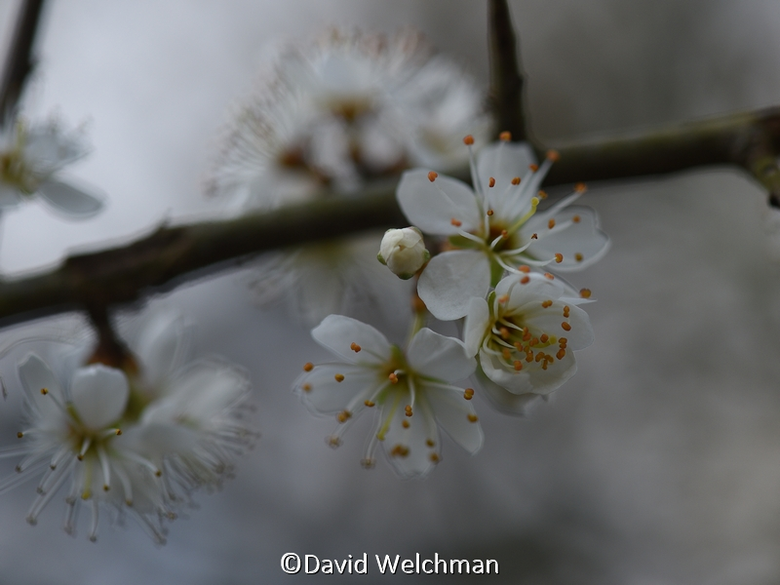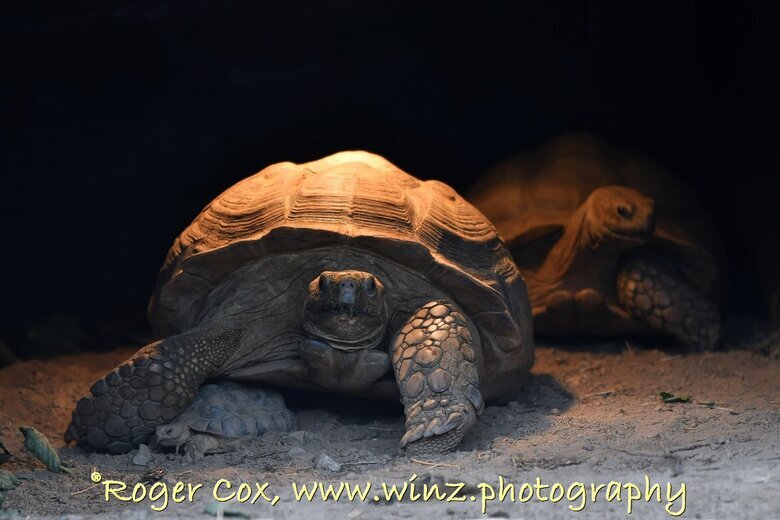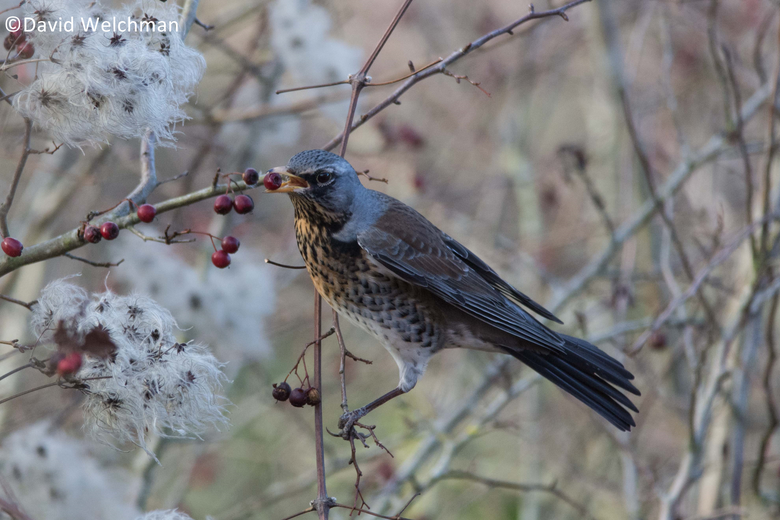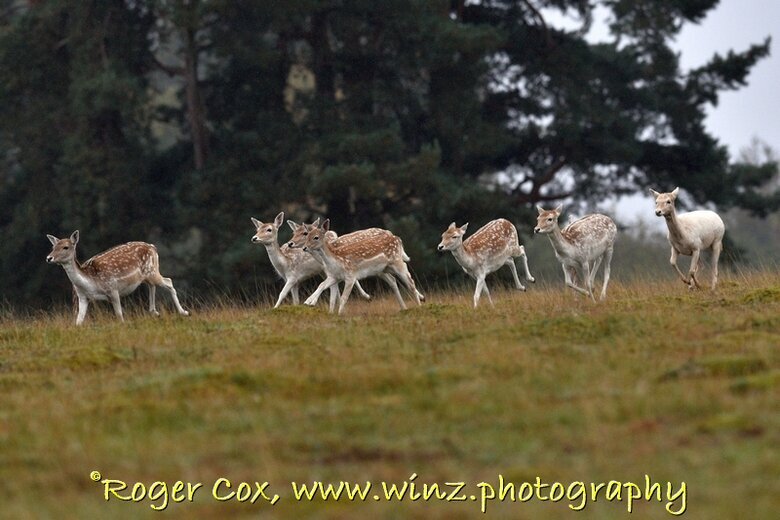Photo of the Month Gallery
The beauty of nature photography lies in the way it often evolves into "surprise photography," capturing rare and unusual moments that are well worth sharing. The Photo Of The Month Gallery is an annual collection of images and accounts by like-minded enthusiasts who were kind enough to share some of their inspirational moments on the PotM Calendar.
May 2025
Arne, Dorset
Spiders have spun, slung and hung their silken threads across the elements of earth, wind and water since the world began. So, for many lifeforms, there’s no avoiding them. Not even on the surface of a wet, weedy pond – a favourite haunt of this bog raft spider.
Throughout the summer, raft spiders not only use water as a web but also as a hideout and a hunting ground. Tiny hydrophobic hairs on their legs allow them to float around the edges of waterways where vibrations in surface tension alert them to prey like pond skaters, including drowning, thirsty, and egg-laying insects. When alarmed, they’ll use vegetation to run below the surface and stay submerged for up to thirty minutes, taking on a cling-film-wrapped appearance by breathing inside a bubble suit created by their water-repellent hairs; predatory ways undaunted, they’ll lurk instead to seize upon unsuspecting water boatmen, aquatic larvae, tadpoles, and small fish.
With a body length of 22mm, they’re the largest spider in the UK, of which there are two species: the bog raft and the fen raft. Both are remarkably strong, able to tackle prey up to four times their size. However, for courtship and reproduction, brute strength and a super urge to kill is tempered in males to take a more cautious approach with their mating strategies, as the larger, more rapacious females are notorious for preying on intruders and suitors alike.
April 2025
The Remains of the Dead by Roger Cox
Berwick Basset, Winterbourne
With its 1.2m wingspan, the common buzzard is Britain’s largest and most widespread member of the hawk family. A frequenter of forests and fields, its mewing calls are often heard across rough grassland, moorland, hedged farmland, and in woodland canopies where it can sit patiently or effortlessly soar for hours over open country, sometimes in pairs, but always with an eye for opportunity.
When circling above on thermals, their heavily barred bodies and the five extended feathers on their slightly raised brown-banded wings give them a more aquiline appearance. Hence, in picturesque mountainous places like the Isle of Skye, locals refer to them as “tourist eagles,” a name derived from the many visitors who wrongly identify them as golden eagles.
Although too slow to chase most birds in the air, buzzards are quick, efficient, versatile, stoop-and-swoop predators, preying on rodents, rabbits, game birds, and even worms! However, a large part of their diet consists of carrion. Though far from being lazy hunters, they often accompany red kites and corvids as they peruse country lanes and motorways for a Smorgasbord of roadkill. As opportunistic scavengers, this morbid exploitation of casualties from the more callous side of motoring may not entirely sway us to admire their graceful gliding and superb hunting skills. Yet, for that one fault alone, they do play a vital disease-preventing role by removing dead and decaying remains from our roads, fields, and farmlands.
March 2025
The Lynx Effect by Roger Cox
West Country Wildlife Photography Centre, Lifton, Devon
Within the Felidae family is one of the most enigmatic cats on Earth – the lynx. Of the four species, two are found in Europe, one as far as northern Asia, the other restricted to the Iberian Peninsula, while in North America, specifically Canada, lives a third species, perfectly adapted to life in the cold, unlike its smaller cousin to the south, the bobcat, a denizen of diverse habitats throughout the United States. All bear the signature short tail, ear-tufts, and bearded cheeks with spots on their legs and torso – enough to confuse any means of identification, but there’s no mistaking this Eurasian lynx, should you see one roaming wild within the British Isles.
This solitary, elusive medium-sized cat was made extinct in Britain 1300 years ago through persecution and habitat loss. Yet some conservationists would like to see it return - a re-wilding fever-dream, perhaps, but one that offers an effective solution for preserving critical habitats with a sustainable ecosystem. As agile ambush apex predators, the Eurasian lynx is stealthy and quick enough to catch small mammals and birds, but its speciality is roe deer. In Scotland, where roes are superabundant, they’d only flourish to exert more pressure on ungulates and smaller predators, allowing more prey species like grouse, rabbits, squirrels and voles to increase, thereby improving the biodiversity of over-browsed and over-grazed empty forested areas, that could well do with a touch of the lynx effect.
February 2025
Birds on a Wire by Roger Cox
Leysdown on Sea, The Isle of Sheppey
As winter turns to spring, field posts strung with barbed wire become boundary lines and feeding spots for a small dark-hooded bird about the size of a robin with a song reminiscent of *two stones hitting each other.
As the breeding season begins, pairs of stonechats flit back and forth between the ground and wired field posts, hunting for seeds and insects, claiming territory (as power couples do) to let others know that some corner of a farmer’s field, that is forever England, is now exclusively theirs – farming practices permitting.
Males in full breeding plumage are striking, bearing a black head and throat, a white half-collar, a white rump, and an orange-red breast. Females are paler but no less given to perching in places of prominence, as if to spy out even more land to expand their UK range and distribution – a notion not so far-fetched, considering what they’ve accomplished in the last 20 years by the chatter they’ve sent by post and wire along the boundaries of our agricultural fencing.
From their western strongholds in Devon and Cornwall, they've crept north and eastwards all from making an exhibition of themselves, venturing as far as The Isle of Sheppey to cover 80% of our countryside – a feat encouraged by milder winters and a nationwide wire-fenced network that has steered them away from annual migrations to exploit fields much like this one, all year round.
January 2025
Marwell Zoo, Marwell, Hampshire
Egypt – a land of antiquity founded on the rocky desert plains of North Africa bordering the southern sands of the Sahara. West of the Nile Valley, a vast, arid, stony region fit only for those animals and plants with specific adaptations to call such gravel-laden wastelands home. Among them is the Egyptian spiny-tailed lizard, a member of the uromastyx1 or thorny-tailed lizard family, a.k.a, mastiguires1.
These highly sought solitary reptiles, with large, powerful jaws, are oviparous2 omnivores – found throughout the Northern deserts of Africa, Iran, India, and Pakistan. Deep, within their burrows females can tend up to twenty hatchlings for several weeks. At first, the youngsters feed on invertebrates but soon develop a taste for vegetation with the help of symbiotic gut flora, which they obtain by ingesting their parents' faeces!
Left undisturbed, individuals can grow up to 90 cm in length and live for several decades – a testament to their resilience under the severity of desert life. However, when unsettled, they not only hiss loudly but can also deliver a nasty bite and unexpectedly use their long, barbed tails to lash out the faces of burrow intruders when threatened or improperly handled. Sadly, from the few population studies conducted for their conservation, the Egyptian uromastyx is now on the IUCN Red List as vulnerable primarily due to habitat loss and its harvesting for food, Chinese medicine, and the pet trade.
1. From the Ancient Greek “oura,” meaning tail, and “mastiga” meaning whip or scourge. This refers to the spiny tails that uromastyx lizards have and use to defend themselves.
2. Producing mature eggs that immediately hatch once expelled from the body.
December 2024
Snowy White and the Severe Cold by Roger Cox
The New Forest Wildlife Park, Hampshire
Few are willing to brave an arctic winter on the frontiers of the frozen north. But as animals hibernate or migrate to escape the blistering windchill of an endless twilight in temperatures as low as -36 oC, one bird is prepared to stay, and surprisingly, it’s an owl.
Owls typically hunt at night and sleep in tree hollows, caves, and nest boxes during the day. They also prefer temperate to equatorial climates. But the snowy owl is different. Couples mate for life, but only the most seasoned adults with the thickest insulating feathers can survive out on the tundra in freezing darkness to roost and nest on the ground. Females like this one at the NFWP, are polar-white with dark bars on their plumage for camouflage against predators while brooding their young. As the family's sole providers, males become whiter with age, ever blending into the background to aid their more frequent hunts for lemmings, fish and birds.
Their golden eyes are no less effective at spotting prey in near darkness as in the light of a 24-hour day, and should their quarry take to hiding beneath the snow, they rely on another keen sense—hearing. Yet, for all their sensory perceptions, it's the quality of the Arctic summers that determines the quantity of their food and, therefore, the likelihood of hypothermia or starvation for their young. A constraint that has put them in the unfortunate position of having one of the highest owlet mortality rates in the world.
November 2024
The Lettuce Eaters by Roger Cox
400 km off the coast of Mozambique is a vast tropical island with palm-fringed white sandy shores, clear blue waters, secluded coves, and misty mountain rivers that surge from its east into a rain forest, only to trickle out to its west across a rocky, wind-swept, barren landscape.
Within this enclave of divided habitats live the lemurs, a diverse group of primates consisting of 103 species, all endemic to the mountains and jungles of Madagascar. Sadly, due to extensive deforestation, purpose-made fires, and poaching, 98% of all lemurs are threatened with extinction, including the iconic ring-tailed lemur, where less than 2000 remain in the wild, roughly the same number now in captivity.
Whereas lemurs prefer to dwell in trees, ring-tailed lemurs spend 60% of their time on the ground, frequently sunbathing with their arms wide apart, else travelling three to thirty-strong in matriarchal mobs, tails held high, whilst foraging for insects, nuts, eggs, flowers, fruit, and leaves. Amongst the troop are ranking males who constantly compete for females by rubbing their tails with special stink glands on their wrists and then wafting that scent into the faces of their rivals—the severity of the provocation being proportional to the strength of the odour. Yet at Marwell Zoo, it’s clear from a preference for lettuce that no such stink is ever created. For *pale and dark-eyed, their grey faces may be, but on the branches that bear them, these lettuce eaters know precisely when to receive their share.
* In reference to The Lotos Eaters by Alfred, Lord Tennyson – 3rd & 4th stanzas.
October 2024
Bourne, Lincolnshire
Photography is all about lighting, with a touch of personal perspective. So, seeing a subject in a different light, especially a wildlife one, can mean several things — like discovering a new facet of its life, using a more unusual portrait angle, or finding an ingenious way to tell a more compelling story.
In rear-curtain sync photography, only the second half of a camera’s shutter is in step with its flash to produce an image. Exposure times of 1/10th of a second or less are used to create a spectral effect from motion blur. The trick is to pick an eye-catching subject, like this triple-image trail of a greenfinch against a dark background—created not only to capture the bird aesthetically but also to focus our attention on the plight of greenfinches in Bourne and the rest of the UK since the early 2000s.
This olive-green finch with a bright flash of yellow in its wings is now classed as *threatened due to Trichomonosis, a pervasive parasitical disease you could say is depicted in the photo by the darkness surrounding it. In contrast, from our sync behind the magic curtain, is a recovery story portrayed by its three-in-one imagery. Starting with the lower faded body representing the bird’s threatened past; the less faded middle, its uncertain present and the more defined uppermost image, its emergence to a more solid future—a story, one would hope, is a true picture of our Greenfinch population and their situation today.
*Listed as Red in the UK Birds Red List, aka Birds of Conservation Concern 5 (2021)
September 2024
Epping Forest, Loughton
Anyone in the UK exploring the great outdoors between March and October, will likely come across our only native snake known to inhabit almost every preserved part of our countryside. With the exceptions of the Highlands, Scilly Isles, and famously, Ireland, grass snakes are found in lowland habitats ranging from parks and gardens to woodlands and wetlands where water plays a significant role for them – 60% of their diet consists of frogs, newts, and fish. However, lizards, insects, small mammals, and chicks are also on their menu, which can drive them to colonise other places whenever aquatic food sources dry up.
Besides being expert swimmers, they’re our largest snake, with females occasionally growing 1.5 metres long! They're also the only UK snake to lay eggs — often in rotting wood, compost, and manure heaps for bio-thermal warmth. As reptiles, heat sources are essential for their reproduction and survival, yet for all their familiarity, they’re elusive and secretive enough for their whereabouts and numbers to remain a mystery. Still, in flower-rich water meadows teaming with tadpoles, full of frogs, else packed with shoals of small fish, you might spot the serpentine movement of an olive-green, beady-eyed eel-like creature slithering between some irises and water reeds, its head above water tasting the air with a flickering forked tongue – or simply chance upon a barred, grey-green snake in the grass, basking in the sun, while out for a casual walk in the woods.
August 2024
Bourne, Lincolnshire
High up, away from the bustle of the streets below, soars a remarkable crow-like bird. Circling above, it suddenly tumbles into a playful swirling dive, dropping close enough to exhibit its diamond-shaped tail and considerable size. After several calls, it’s joined by its mate, and the two go into a synchronised sky dance. Stooping simultaneously downwards, barrel-rolling with talons briefly locked and then separating, only to thrust themselves upwards to randomly repeat the performance six or seven times while calling to one another.
These impressive supersized corvids, weighing 1.13 kg and a 1.2m wingspan, are ravens—making a comeback in SE England after decades of persecution. Between February and April, their spring courtship displays are once again a regular occurrence over the farms, forests, and suburbs of South Lincolnshire.
Ravens are highly intelligent, inquisitive, expressive, resourceful and vocal – creating and mimicking more sounds than any animal on Earth. They share the same diet and sometimes habitat as carrion crows, but being twice as big with a lifespan three times as long, aren’t so allied to their smaller cousins to regard them as anything more than food. Yet these grim opportunists, thieves, spies, and “rascals of the skies” are resolute when choosing a partner and territory since they do so with a ‘til-death-do-us-part commitment to both — a characteristic eerily depicted in Edgar Allen Poe’s classic visitation poem, where in the face of foreboding others are expected to fly from corpses, partners and places, yet “Quoth the Raven – Nevermore.1”
1. From the 10th stanza: "But the Raven, sitting lonely on the placid bust, spoke only; that one word, as if his soul in that one word he did outpour. Nothing farther then he uttered—not a feather then he fluttered—till I scarcely more than muttered “Other friends have flown before—On the morrow he will leave me, as my Hopes have flown before.” Then the bird said “Nevermore.”
July 2024
Victoria Park, Bow, London
As one of Europe’s most wildlife-invaded countries, the UK is home to hundreds of alien species. Some, like the little owl and brown hare, are more eco-friendly and therefore less problematic—unlike this yellow-bellied slider, which has managed to colonise dozens of canals, ponds and lakes as an unwanted pet.
In the past, over 600,000 terrapins, mostly red-eared, Cumberland, and yellow-bellied sliders, were imported to Britain, with an estimated 4000 of them deliberately released into the wild! Originally from the warmer parts of the Eastern and Central US, our climate is rarely kind to them. Basking begins in spring, but with barely enough sunshine to metabolise calcium and vitamin D, they struggle to harden their shells, hatch from any eggs in temperatures below 24 o C, or store enough fat reserves to hibernate in winter.
Our weather may have hampered their progress but has done little to lessen their appetites. Terrapins are voracious omnivores that can live for forty years, depleting aquatic habitats as they compete with a host of native animals that rely on invertebrates, fish, amphibians, and certain plants for their food. They also pose a human health risk as a potential salmonella reservoir. Hence, their status as aliens is clear—they’re not welcome. As of August 2016, it’s illegal to trade or breed terrapins in the UK. It’s also highly irresponsible to keep them without the proper facilities and care, but above all, utterly criminal to release them into the wild.
June 2024
Roydon Wood, The New Forest, Hampshire
Given their idyllic songs, benign appearance, and skittish behaviour, one might suppose thrushes to be timid, genteel birds with more flight to them than fight. They do take a more aggressive stand in winter to protect hard-to-come-by berry bushes, but if there’s one thrush more capable than most of throwing its weight around to prove a point beyond posturing, it’s the dotted and dapper missel or mistle thrush.
So-called for its supposed liking for mistletoe berries, the mistle thrush is the largest of our thrushes and lives on a seasonal variety of seeds, fruit, and invertebrates. But period-driven food shortages aren’t the only sparks to ignite them into a state of aggression with more weight behind it than a rival might presume. Another name for them is Stormcock, as they’re said to be undaunted by the weather when singing or defending their nests and young against threats as formidable as sparrowhawks, barn owls, and buzzards. As parents, they show tremendous courage by swiftly executing fierce attacks on raiders, as if to "put the missile" into the missel part of their name. From the very tops of trees, a pair will vigorously and mercilessly dive-bomb an adversary with such ferocity that one such incident recorded by 1Cocker and Mabey, resulted in the death of a trespassing jackdaw – a freak accident, perhaps but a blow delivered with enough daring to earn themselves a reputation for being the sort of bird intruders often underestimate to their peril.
1. The Birds Britannica by Mark Cocker and Richard Mabey, where the authors detail how a pair of mistle thrushes defended their nest by “driving away a sparrowhawk and buzzard, knocking a barn owl off its perch and attacking and killing a jackdaw.”
May 2024
Cats are said to have nine lives, but according to the ICUN Red List of Threatened Species, twenty-one members of the lesser cat family are all nearly down to their last one. Amongst them is Britain’s wildcat, which, despite being listed as “of least concern”, is classified as functionally extinct due to widespread interbreeding with feral cats. At first glance, it’s easy to mistake this beguiling solitary hunter for a stray or regular tabby – but a Jasper, Tiddles, or Tibby, it is not.
Before the seventeen hundreds, the wildcat was found all over Britain. But from the widespread practice of gamekeeping, it was purged in earnest throughout England and Wales to live chiefly in the remoteness of the highlands, where the word “Scottish” was later added to its moniker, spawning the nickname Highland Tiger – and much like those outlaw Jacobites of old: a mysterious, elusive, and ill-tempered creature, characterised by a rebellious spirit of independence.
Although all that remains of it in the wild are rampant strands of its DNA, the Scottish wildcat is a distinct variety of the Eurasian wildcat and, therefore, unique. So, it falls to us to preserve its bloodline in the purest form and not allow it to vanish over native soil like a proverbial Scotch mist, which is why this one at the Westcountry Wildlife Photography Centre is part of a captive breeding program that hopefully will someday see our “rarest carnivore” once again roaming the wilds of Britain.
April 2024
Instantly recognisable by their raucous chatter, long tails, and tuxedo-like attire, Eurasian magpies are corvids well-known for their audacity and intelligence. But it’s their acumen, not attitude, that has them living off the leftovers in our towns and cities — a significant contributor to their urban survival, which, in addition to their natural diet of seeds, insects, fledglings, fruit, small mammals, and carrion, has boosted their success across a wide range of habitats in almost every part of the UK.
After centuries of resentment for their nuisance to seed crops, poultry and game bird eggs, magpies have developed an inherent distrust of artefacts, especially those resembling traps and guns. Famous for their cognitive abilities and episodic memories, they can quickly learn to exploit food sources and pass that knowledge on — an admirable quality for any bird with a talent for mimicry and a curiosity for shiny objects, but their tendency to the mob, rob, and steal from others has won them few friends. Hence, a reluctant appreciation for them as predators, scavengers and pest controllers, as with this unwanted opportunist, craftily captured drinking at this impromptu watering hole in Tower Hamlets Cemetery Park.
Still, their peacock-blue wings and green sheen tail feathers are some of their more attractive features. Colours incongruous to their unpopularity, perhaps, but a blend in their plumage that typifies those mixed feelings we have towards them — a reaction in one sense much like the magpie, in that its not so black and white.
March 2024
For male lions, governing a pride means spending most of your waking hours fighting and patrolling miles of territory to protect your resources and offspring from rivals, even amongst your progeny. Yet, despite filial alliances and coalitions between males, these 200 kg family heads hold positions belonging to some of the most battle-scarred big cats in the animal kingdom.*
At age three, male lions are expelled from their pride to complete their rite of passage from cub to king in a nomadic journey that will test their strength, courage, cunning and resilience. Having more bulk and less stamina, they’ll develop their predatory skills as ambush hunters, fight to steal kills and scavenge whilst avoiding territorial roars, until they’re ready to face the challenge of claiming land and lionesses of their own by partnering with fellow outcasts bound by blood or similar goals and interests.
When travelling in a pride, alpha males help with hunting but take the lion’s share of everything regardless – a privilege at the price of their mortality! After routine spells of oestrous copulating followed by almost twenty hours of sleep, it’s back to the ferocity of the front lines, where bouts can be brutal and injuries lethal; an undertaking this captive-bred cat living scar-free on whole sides of horse meat every week may well prefer to yawn at rather than roar against – given the harsh realities* of what it costs as a king to be born free.
*Content Warning: link to scenes of severe animal injury and violence that some may find upsetting.
February 2024
The Forest of Dean, Gloucestershire
Until 1897 it was thought that Britain was home to only five kinds of Paridae1 or true tits. Since they all differed in appearance from one another, it was assumed that identifying each species in the wild presented no great challenge – until it was discovered that one of them had a double by way of a close cousin.
For the keen bird-watcher, spotting a marsh tit in the company of willow tits and vice versa is probably one of the most perplexing and exasperating headaches faced by any British birder. Both species share the same winter and summer diets, and although their habitat preferences are dissimilar, they’re known to coexist where their ranges overlap. Even the more distinguished features like the glossy black cap of the marsh tit can appear as a matt one in fluffy-feathered juveniles, giving the impression of a willow tit, and the tell-tale “pale wing patch” of the willow tit, which is sometimes missing, can create the spitting image of a marsh tit.
To add to their long list of similarities, both species are now in decline. Yet, for all their small and hidden differences, the best way to tell them apart in the field is by their song. “A willow tit has a zee-zurzur-zur call, whereas a marsh tit sounds like pitchou.” Unfortunately, this suspected marsh tit in The Forest of Dean was silent, which, once again, left some doubt to its true identity, thanks to that infuriating family resemblance to its near-identical cousin.
1. Initially, Britain’s five true tits were the great tit, blue tit, coal tit, crested tit, and marsh tit. The willow tit was the last native breeding bird to be recognised here in 1897, bringing the UK Paridae species count to six.
January 2024
In ancient China, when King Chuang-Wang of the Chou dynasty lost his gibbon, he ordered an entire forest to be laid waste to find it. How successful this drastic action was in recovering his favourite pet isn’t clear. But the destruction was to echo a distant warning for many of S.E. Asia’s remarkable forest-dwelling animals like the now-endangered lar gibbon.
Lar gibbons have the most extensive north-south range of all the gibbons, stretching from Northern Indonesia to Thailand – the territorial limit to their resounding hoots and howls, which sadly, are no longer heard across the Thai border with China, where that ancient edict of King Chuang-Wang appears to have transcended the boundaries of time and place to the rain forests of Indonesia, Laos, Malaysia, and Myanmar for roads, cattle, agriculture, logging, and palm oil plantations.
To add to their plight, adult lars are poached for their meat, with any surviving babies taken for the illegal pet trade. Hence, many like this one at The Lake District Wildlife Park end up in zoos, spending much of their time sitting on flat surfaces and walking bipedally with their arms raised above their heads for balance. However, in their native environment, they rarely come to the ground – a dream life for those in captivity, but with much of their habitat now gone, where else can these arboreal primates see themselves howling whilst freely brachiating[i] from tree to tree, except within the blissful realms, of lar-lar land.
[i] locomotion accomplished by swinging the arms from one hold to another.
December 2023
A Most Dangerous Game by Roger Cox
Brownsea Island, Dorset
First brought to Europe from Asia by the Romans and then to Britain by the Normans, the common pheasant has been bred as a game bird since the 1600s, yet despite an annual release of over 40 million of them for shooting, relatively few live to reach maturity.
Between October and January, birds that manage to escape the beaters and guns come poorly equipped for life in the wild. Being caged from birth and then suddenly thrust out into the countryside, many lack the intelligence to fly far away. Others need time to orientate themselves towards places of food and safety and identify dangers they must learn to avoid. Yet, time is a luxury they can scarcely afford. Perils and predators abound, and from our widespread use of cars, their introduction to the pace of modern life is typically the end of the road for many a gormless pheasant thirteen times more likely to be run over than any other British bird.
As bird-brained as she may be, no such outcome awaited this half-witted hen within the safety of Brownsea Island, where the threat responses of pheasants there are as thick or as sparse as the cover they shelter in – a striking contrast to the fate of millions of them now facing that perilous flush towards freedom, only to someday gamble their lives in a most dangerous game by crossing a country lane, perhaps in front of my car, or possibly yours.
November 2023
Beaconhill Country Park, Leicestershire
In the 18th century, Lord Milford, a maverick landowner and falconer, sought to employ the niche hunting skills of Europe’s smallest owl as a pest controller. However, their confinement to his estate was short-lived as the birds quickly took flight through every door and window of opportunity afforded them. By 1758, the so-called Milford owl, now aptly named little owl, was reported as living wild in London, where its propensity for creatures inhabiting the crevices of houses, barns and stables was again exploited for pest control – a nationwide practice from 1843 onwards.
Weighing 170 grams with a wingspan of 56 centimetres, this wide-eyed, angry-looking, spotty little brown raptor hunts whatever it can. However, due to its diminutive stature, preys mainly on worms and insects.
Being strongly territorial and pairing for life, they’re no slouches when defending their homes, which are often tree hollows. Yet they prefer nest boxes and derelict farm buildings – a synanthropic* benefit they’ve come to rely on since agriculture began.
Sadly, as a non-native indicator species, little owls have no official conservation status and, therefore, little hope of making any significant recovery from habitat losses or the use of pesticides. Combined with their unyielding territorial behaviour, individuals are sometimes found terminally surviving on the smallest of chances against the greatest of challenges in a changing land-use versus their behaviour conflict that has seen their numbers decline as much as sixty-five per cent over the last twenty-five years.
*organisms adapted to live near humans, such as pigeons, rats, mice and house sparrows.
October 2023
No matter how many names we give an animal, any type of behaviour created by its environment is habitat-specific – something that can’t be said of the puma, cougar, mountain lion or catamount, which has over forty different names in English, with none that do justice to its ability to overcome dozens of environmental constraints and challenges across two entire continents.
From the Yukon in northern Canada to the southern Andes, pumas have the broadest range of any native land mammal in the western hemisphere. They’re incredibly adaptable and found in almost every habitat, including deserts, high mountains, forests, swampland – even suburbs and cities! Whilst they’re still found in every country in South America, in North America, centuries of persecution and their eradication for ranching and farming have reduced two-thirds of their range to the western United States, except for the Florida Panther in the Everglades.
Lacking the necessary cartilage in their throats to roar, pumas aren’t classed as big cats. Still, as the world’s largest meowing moggy, they’re no less adept at taking down prey many times their size. Ghost-stalking deer, elk, guanaco, vicuna, and even moose, leaving tracks that eerily disappear with a 5.4m vertical jump up a tree or a 12m leap over a brook, as demonstrated by this one at the Big Cat Sanctuary in Smarden. Sadly, elsewhere, in most of the US, their haunting pawprints are now gone for good, whereas once upon a time in the Americas, they could be found – or not, virtually everywhere.
September 2023
The Ones That Got Away by Roger Cox
The New Forest Wildlife Park, Hampshire
While stories of big cats roaming the British countryside are supposedly modern day myths, there's a real alien about that tends to have its witnesses jump with as much excitement as it does. As incongruous as they are on the South Yorkshire Dales and Chiltern Hills, feral red-necked wallabies have surreptitiously lived amongst us for over a century, occasionally making headlines with chance encounters and bizarre sightings from Inchconnachan Island to the Cornish coast.
Originally exported from Eastern Australia as a popular attraction for zoos and menageries, they soon proved themselves to be accomplished gaol-breakers with the canny ability to survive in temperate climates. Being fast on their feet and able to leap over obstacles, many quickly found freedom during WWII as keepers and collectors had little time to track down and recapture escapees. Of the ones that got away, unspecified troops were established, with the highest recorded numbers on the Isle of Mann.
As shy invasive herbivores, little interest is paid to them until they make a newsworthy public appearance, like this one, inside the open enclosure at the New Forest Wildlife Park, where the attention it received was more than it had hopped for when in two clicks of the camera, it retreated into a shrubbery.
August 2023

The Flight of the Mild Geese by Roger Cox
Regents Park, London
Visit any wetland, estuary, lake, pond or canal at any time of the year, and you’re almost sure to spot gaggles of a large brownish goose with a signature white chinstrap, a buff-cream belly and breast with a black head, neck, and feet.
Being our largest and most widespread naturalised goose, Canada geese have an average wingspan of 1.7 metres and a weight of 4.8 kilograms. So to see one taking off on water is an impressive display of strength in proportion to size.
From its humble beginnings three centuries ago as an ornamental goose in St James’s Park to a popular exhibit on the lakes of the landed gentry, its scarcity in the UK has now diminished to 64,000 breeding pairs. Where its adaptability to artificial landscapes, and predator-free nesting, has seen its numbers more than double in some years. However, mixed reactions surround its success. To some, they remain an attraction to parks and ponds, but to others, they're eyed as a North American nuisance, seen only as a crop and playing field pest.
Undaunted by our contempt for their grass and grain-eating vandalism, the population now stands somewhere in the counting of 200,000 sedentary birds, unlike their seven million progenitors across the pond, who, in mild weather can migrate in V-formation a staggering 1600 kilometres a day – an astonishing feat, much like their landings on water, that never fails to make a splash.
July 2023
Brownsea Island, Dorset
Nobody likes a turncoat, but what if a coat change was your sole means of defence against the watchful eyes of a predator? Take Sika deer, for example: similar in size and summertime appearance to fallow deer, it has a brownish coat with pale spots, that grows distinctly darker in winter. it also has a white tail patch to alert others in the heard while running away – something only a big cat or marksman would object to.
Sikas came to Britain from the Far East in 1860 and were kept on private country estates. Later, some escaped, and because all the free-living ones in Britain were Japanese sika, most, if not all of their descendants, were thought to have come from only one stag and three hinds from the Viscount Powerscourt’s deer park in Enniskerry!
Being part of the Cervus family, sika deer (Cervus Nippon) are smaller distant relatives of red deer (Cervus elaphus), which means they can interbreed – a genetic extinction threat triggered when both species reside in the same territory. Today, it is thought that all the deer in Wicklow (Dublin, Ireland) are sika-red deer hybrids!
Thus far in Britain, purebred sikas can still be seen turning their coats in the more remote reaches of the Scottish Highlands, managed strongholds like The New Forest, and within exclusive areas of land like this hind thoroughly enjoying a moment of pure relaxation on Brownsea Island.
June 2023
Robin vs Robin by Roger Cox
In winter, many birds form flocks to survive or migrate. Not so for European robins. Throughout our darkest months, these red-breasted songsters stoically maintain a solitary vigil by chasing away rivals who might otherwise invade their air space.
Whilst robins of the opposite sex with overlapping borders tolerate one another, they remain fiercely territorial. Even females are not averse to seeing red should an incursion occur when food is scarce. It’s a temperament often seen around bird feeders, making them bold enough to grow accustomed to people who frequently feed them. In truth, no other wild species of small bird within the British Isles has the brazen charm to take on such a tame demeanour, and yet, as spring approaches, show a far less endearing side as males become aggressive towards other males.
At the start of the breeding season, cock robins tout their prowess by throwing their heads back and chests out while swaying from side to side; a red flag, if you like, from one robin to another, warning them that any assertion of rights to food, water, or a favourable nest site will no longer be frowned upon - all will be challenged, and with more than a mere peck to respect the order of things. A point driven home by the tips of their beaks and the claws of their feet should a rival dare cross any red-breasted boundary lines.
May 2023
The Wild Bunch by Roger Cox
When Wordsworth “wandered lonely as a cloud” over the “vales and hills” of the Lake District, the daffodils referred to in his classic poem were naturally occurring, uncultivated, and superabundant. Today, their variants abound. Yet, unlike those gaudy imposters that appear from February to April in our gardens and green spaces, native wild daffodils are seldom seen in the wild.
This old Easter perennial, also known as the Lent Lily, once covered acres of Britain's hills, coastline, meadows and forest floors but, sadly, is now reduced to inhabiting a few sites of special interest in the Welsh Black Mountains, Cumbria, South Devon and now, of all places, Tower Hamlets Cemetery Park!
Indeed, an urban rarity has taken root in a corner of London’s East End, where crowds of wild daffodils can be seen, as Wordsworth might say: amongst the graves at every pass, bunched and blooming in the grass. Flourishing not for a season long. An arrival in which their flower harks, the wren and robin’s mating song. Until summer dawns, to which their fading marks.
They’re more delicate and typically smaller than their more colourful cousins; about thirty-five centimetres tall, with narrow grey-green leaves and cream-coloured petals – not a great distinction to boast of, but they're not alone in blowing their own egg-yolk yellow trumpets when connoisseurs of native UK plants are proud to point out their East London peculiarity, or when poems and their pictures are shared by those who genuinely appreciate them.
April 2023
Snow Bunting by David Welchman
Iceland
Snow buntings are special for many birdwatchers. They are most commonly seen in the UK as winter visitors, especially in Scotland and northern England and along the shores of the east coast. They feed on seeds, particularly those of Juncus species rushes in the north and are apparently partial to sand hoppers on the shoreline. Very small and variable numbers also stay to breed in rocky areas high in the Scottish mountains. In summer, the adult males have striking black and white plumage, which they lose in winter when they show a more buff colouration; the bird in this picture is likely to be a female or perhaps a first winter male.
The snow bunting has a circumpolar distribution and must count as one of the hardiest small birds. This image was taken in Iceland in February on a volcanic rock just outside a well-known tourist destination, the geothermal Blue Lagoon. A group of three birds was oblivious to people walking past less than two metres away. In winter, snow buntings can be seen in urban areas and even gardens in some parts of Iceland, and return to their mountainous areas for breeding. The Icelandic race of snow buntings differs slightly in their markings from most birds breeding in Scotland. Birds are usually seen on or near to the ground, and in the breeding season, the male displays a musical song flight with his wings fluttering like a skylark.
March 2023
Six centuries ago, Scandinavians spoke of a large white roof-dwelling bird that delivered newborn babies. Back then, it was customary for Nordic people to marry during the summer solstice when storks began their annual migration from Europe to Africa and returned nine months later to raise their young. Their arrival would herald the springtime baby boom, giving rise to the notion that their presence was somehow connected to a safe delivery during childbirth. So began the myth of the winged white stork successfully bringing a child to its jubilant parents.
They're still considered a sign of fertility, new life, good fortune and prosperity. So, on returning to Europe’s towns and villages, many are encouraged to nest on purpose-built platforms on rooftops and poles. Arriving first, are the males followed by the females a week or so later. Yet despite a preference for the highest and flattest surfaces, they're not so adept at nest building. Construction consists of a circular bed of twigs filled with soil, leaves and grasses. Something they add to every season that can gradually weigh as much as a ton as the years go by.
It was once thought they paired for life, but research has shown that storks are more faithful to a nest site than a mate – sites that are vehemently contested whenever a former partner or pair return later than expected. Indeed, disputes with owners who rule a roof can be so violent that rivals ousted by them know to stay clear of the storks of the town.
February 2023
The Rule Of Three by Roger Cox
St James' Park, London
It’s well-fabled that good things come in threes. E.g., the story of Goldilocks and the three bears, the three wise monkeys, the three little pigs, and why they're at least always three pelicans in St James’s Park.
Three, that abiding number for a strong family bond and lasting friendship, is the starting point for the behavioural development of the Eastern white or Rosey pelican. Trios of which have resided at St James' Park since first presented to Charles II by the Russian ambassador in 1664.
Weighing up to 15 kg with a wingspan of 360 cm, pelicans are not only some of the heaviest flyers in the world but are highly sociable, living in pods, often forming large flocks and colonies, where their reproductive cycles become synchronised, as laying, hatching, and fledging coincide - the same of which could be said for this trio as they postured and preened in unison after feeding time.
Although their numbers in the park are few, numbers still govern their breeding and behaviour. Studies on captive birds show that in groups of ten or less they produce infertile eggs; in groups of four, they tend to misbehave. So, in the interests and safety of all, “always three there are, no more, no less.” However, in 2020 more good things came along when three new birds were introduced, bringing their total to six. A factor that appears to have doubled not only their attractiveness but also the efficacy of the rule of three.
January 2023
Duel in the Sun by Roger Cox
Bradgate Park, Leicestershire
October. High noon, and on the valley plain of a park in Leicestershire two red deer stags face one another in a hostile take-over for breeding rights to the hinds in their charge. On the left, the reigning champion, who thus far has managed to fend off all challengers to oust him and lay claim to his sizeable harem. On the right, an upstart pretender, hoping to expand his budding herd and reputation with a swift and decisive acquisition of everything his opponent has fought long and hard to keep.
Five metres apart, and the message is clear; the fight is on!
Suddenly, in a clash and tangle of antlers, the two become locked in mortal combat, and as push comes to shove, backs arch and straighten; neck and leg muscles flex as tendons strain under the brute force of calves and haunches driving forward and against to weaken the other’s resolve – else gouge or gash them into submission. Yet, it's the leaner, more experienced champion who summons the might of his sinews to press the attack, gaining more and more ground to lift his opponent's head, causing him to lose his footing and concede defeat by way of a hasty retreat.
To the victor, go the spoils – a nearly seventy per cent stake in the bloodline of the next generation, and for his progeny the prospect of a dynasty, all founded on a few hard yards won from a gruelling, if not fateful, duel in the sun.
December 2022

From Hare to Uncertainty by Roger Cox
Attleborough, Norfolk
Two millennia ago, a rabbit-like mammal was brought to Britain by a mighty imperial army with designs on conquest and trade. Four centuries later, the invaders left, leaving said mammal to fend for itself in the wake of their crumbling empire. However, the brown hare thrived and until the eighteen hundreds, did far better at occupying the land against any amount of native hostility than the Romans, who were said to have introduced it.
Being an invasive species, its meat was game then, as it is now. But since the advent of modern agricultural practices, brown hare numbers have steadily declined, plummeting by more than eighty per cent over the last hundred years to reduce this once widespread yet prolific animal to a rural rarity in places like the South-West, where it may even be locally extinct.
Hares feed mainly on herbs and grasses – a food source never in short supply, and since they can produce up to three litters a year, the reason for their disappearance is unclear. Could it be our intensive and specialised farming methods, a growing number of countryside foxes, or the lack of legal protection for them as game animals and crop pests?
What is clear is that they’re famously fleet-footed. After observing this one, peeking through the scantest of covers, it soon bolted at what could well have been forty-plus mph, a speed, perhaps, as fast they appear to be vanishing from our countryside.
November 2022
Feral Shades of Grey by Roger Cox
Victoria Park, Tower Hamlets, London
Grey – a colour we associate with the dull, depressing, unassuming, or else things neither here nor there. From grey skies to grey areas, it’s fair to say that anything with grey in its name or description is unlikely to set our minds ablaze with interest. That is, until we look at the greylag goose.
Of our four grey geese, the greylag is the UK’s largest native goose and the most widespread. Being the ancestor of the domestic goose, it may well have such a wide distribution from a historical surplus of captive birds, selectively bred from as early as 1360 BC! Feral birds are now so numerous that it’s impossible to gauge the size of native populations.
Some, like this one, reside around urban lakes with considerable human influence on their diet and life expectancy. Naturally, that would be about eight years. However, well-fed individuals have been known to live for as long as twenty years. Oddly enough, they’re the best divers of all wild geese and yet spend most of their time on land, retreating to water for safety and sometimes to feed.
While the species remains abundant and thriving, UK greylags are threatened with genetic extinction. So, should you visit your local pond to chance upon an unassuming flock of geese, don’t be fooled by the noise and number of those with that dull-as-dishwater appearance; honking they may be, but from a conservation perspective, they may well be calling for a greater degree of concern, or at the very least, a small amount of passing interest.
October 2022
Bradgate Park, Leicestershire
As Summer turns to Autumn, red deer come into season. So begins that long-awaited event of the year for stags in their prime, the rut – a gruelling contest of strength and determination for the toughest and strongest amongst them to acquire exclusive breeding rights to as many hinds as possible.
The benefit of these brutal tournaments goes to the species as a whole. For in spring, fawns are born, sired by the finest of the fittest, whose genes keep at bay any number of random weaklings that could threaten the health and vitality of the next generation.
Delivering offspring between May and June allows for ample food and cover whilst belonging to a herd bolsters their protection, but safety in numbers isn’t the only problem hinds need to figure out. Because females stay with their mothers for life, and males leave before their first year, hinds can control the birth ratio of females to males. Typically, this is 2:1 since stags rarely survive ruts beyond twelve years compared to a hind’s lifespan of twenty or more. Hence, when times are hard, hinds produce more males, which leave within a year, thus reducing pressure on food sources.
Economising on care by producing more males to struggle elsewhere sounds calculating and callous. But such spartan measures are necessary to ensure the herd's future with a minimal loss of life – a bargain for the price of healthy offspring to come.
September 2022
The Imitation Game by Roger Cox
Newhaven, Lymington, Hampshire
Imitation - the sincerest form of flattery. However, in the world of birds, it's difficult to say which species imitates what at times or why.
Take, for example, the common tern: a migratory coastal bird with a forked tail that goes by the nickname sea swallow, and like a swallow, its stamina and slender pointed wings enable it to fly long distances. Yet its hunting technique is similar to kestrels, hovering over the water to dive for small fish instead of mice on land. But the imitation game played out in the behaviour of this silver-grey seabird doesn't end there. Whatever characteristics they appear to have copied from kestrels and kingfishers also include one of the most identifiable features of the black-headed gull, commonly confused with another lookalike, the Mediterranean gull.
Inland breeding occurs in isolated monogamous pairs dotted around lakes, marshes and estuaries; as a coastal rule, common terns are gregarious, nesting in noisy colonies less messy than most as the adults defecate away from the site. At the start of the season, whole colonies repeatedly take flight in a random pseudo-panic known as a dread, where they suddenly fly up in alarm to swoop down and land again as if surprised by a predator.
As to the purpose of these simulated attacks and imitative threats — perhaps a show of strength to deflect their vulnerability while nesting on the ground, if so, it’s a clever form of deceit and defence, sufficiently worthy of sincere admiration.
August 2022
Goshawk Down by Roger Cox
Whissendene, Rutland
High up in the boughs of a remote wood lives a fearsome-looking raptor. Patient and still, two beady eyes stare well beyond its cover of branches in search of a potential victim. Smaller than a buzzard yet mightier than a falcon, a goshawk waits for an opportunity to present itself. Similar to a sparrowhawk, but with a much larger build, it quietly sits, poised to attack as it spies out its surroundings for the slightest sign of prey.
Goshawks are intelligent, calculating ambush predators. On familiar ground, they can manoeuvre through branches and brush at high speed towards a target. Long legs and powerful, piercing talons ensure a deathly capture, though kills are often clumsy. This one, pictured atop a downed pheasant in an open field, is a trained bird. Harnessed and tamed to demonstrate their seldom-seen hunting skills.
Unfortunately, by the 1800s, mainly through the efforts of gamekeepers and egg collectors, goshawks disappeared from Britain. Yet despite several re-introductions in the 1960s, sightings today remain rare. Perhaps their stealthy manner and a preference for heavily wooded areas away from people is why they're so elusive. Remarkably, four-hundred and thirty breeding pairs have been recorded in the UK, though precisely where only their display flights in early Spring can say. Still, it's safe to say that after observing their prowess in the field, the best chance of seeing a goshawk in the wild still lies with those mammals and birds that never see one coming – until it's too late.
July 2022
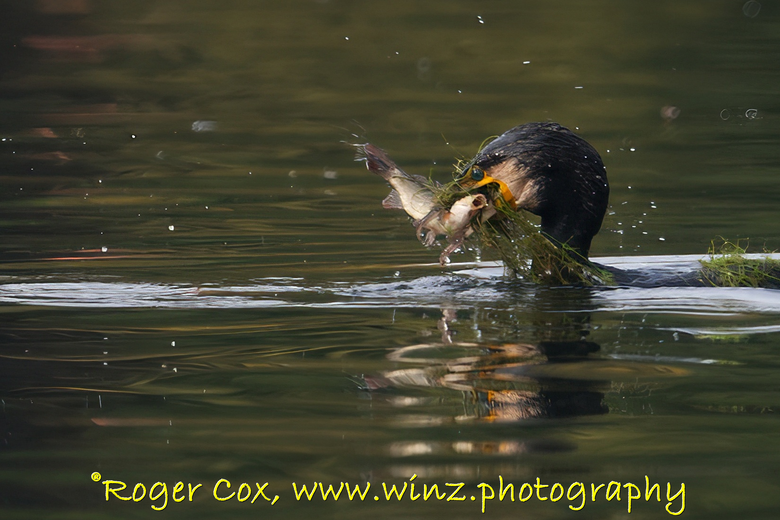
Victoria Park, Bow, London
By adapting to niches and extremes of habitats, birds have colonised almost every part of our planet. Many are specialist hunters or feeders, whilst others enjoy the best of both worlds – often displaying characteristics that explain their names, behaviour or bizarre appearance.
One avian oddity, with a moniker to match, is the great cormorant or sea raven, a subspecies native to the Baltic Sea. This peculiar green-eyed duck-shaped marine bird with a hooked bill and large webbed feet, is not only the world's most widespread flying fish-eater but a recent colonist of inland waterways, and the bane of anglers for reducing freshwater fish stocks.
In truth, adult cormorants only require 500 g of fish a day. Most of their time is taken up with roosting, affirming pair bonds, or waterproofing their feathers with oil from a special tail gland. Consequently, their darker feathers develop an iridescent bronze sheen during the breeding season, when males grow a crest with white patches on the breast, face, and neck. Though they still need to dry their wings after using them like rudders when diving for fish – a feat, they can perform for seventy seconds up to a depth of forty-five metres!
Like raptors in falconry, cormorants were once widely used for fishing. In some cultures, a loop is tied around a trained bird's neck preventing it from swallowing whenever it surfaces with a catch. Thankfully, the practice has largely died out, marking an end to their treatment as living fish hooks.
June 2022
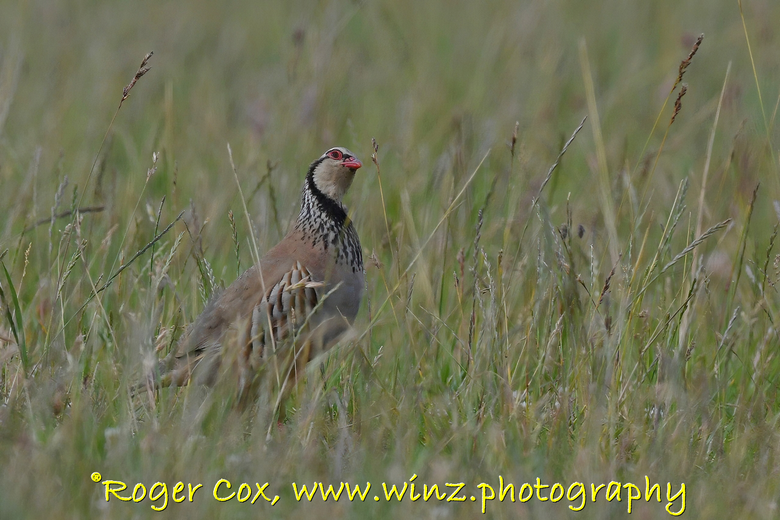
Elmley Nature Reserve, Isle of Sheppy
Between September and January, millions of captive-bred pheasants, quails, grouse and partridges are released into the British countryside – only to be shot dead in their tens of thousands. The upshot to this kind of slaughter is that game birds that manage to dodge seasonal bullets can have high population densities in the wild, though not all escape the beaters and dogs with a sporting chance.
One unfortunate favourite for the gun-sights of a twelve-bore is the red-legged partridge. Originally from the Mediterranean, this lesser-known member of the pheasant family was introduced to Britain from France in the 18th century. Hence its nom de a region, the French partridge.
Since it prefers to nest in flat, lowland open spaces, especially those inhabited by rabbits, it's also game for predators. So, to compensate, hens double down by laying one clutch for themselves and the other for their mates to brood separately. It's a gambit that occasionally pays off - though frequently undone by a risky twenty-four-day incubation period.
Still, it's a win-win for all ground-nesting birds at the Elmley Nature Reserve. In the absence of guns and only the occasional raptor to get alarmed about, this red-legged cock was red-blooded enough to fancy his chances with any number of come-hither hens – and plucky enough to win the attention of a few of them too!
May 2022
Tower Hamlets Cemetery Park, Bow, London
Far from any notion of losing their way in a storm whilst fleeing en mass from a lost habitat, the story of how the rose-ringed parakeet came to Britain is as fabled as the facts – for as the facts go, no one truly knows how it got here.
The first recording of it living here in the wild was in 1855. No doubt all sightings since were of escapees. But the number of feral pets then would have been too small to have genetically sustained the population explosion and noisy nuisance they've become today.
Their notability coincided with Britain's 1950s post-war immigration boom, but these are parrots not of the Caribbean. One popular myth cites the rock star Jimi Hendrix as freeing a pair from his Carnaby Street flat in 1968. Other famous origin stories include a damaged animal container at Heathrow Airport and a break-out of birds from a sound stage at Isleworth Studios for the 1951 film The African Queen. Clues, perhaps, to their importation and unlawful release from a subtropical country within The Commonwealth during that era.
Granted, their journey from Africa, India and Pakistan as pets in the 1800s to establishing themselves as "the world's most northern parrot" is an remarkable feat of naturalisation. Though, how they became so prolific remains a mystery. Still, with 8600 breeding pairs around the South East, these bright green interlopers are now well-ensconced as another exotic addition to London's bird life.
April 2022
Northern Lights by David Welchman
The Northern Lights (Aurora Borealis) are best seen in the Arctic, although they can occasionally be seen as far south as southern England. They have long been revered, and indeed feared, by the native Sami people of northern Finland and neighbouring arctic countries, and many traditions and legends have grown up to explain them. In essence, the current scientific explanation is that the process starts with solar storms, which release vast amounts of charged particles from the sun's surface, which travel at high speed towards Earth. The particles are drawn to the magnetic poles. Hence, the effects are most easily visible in the polar regions. Interaction of the particles with oxygen and nitrogen in the upper atmosphere produces the characteristic colours, most commonly green but also sometimes other colours.
Forecasts can predict the occurrence of the northern lights based on solar activity, but exact predictions are difficult. The lights are most easily seen on clear nights, particularly between August and April. Cloudy conditions and light pollution can prevent the lights from being seen at all. They can be seen at any time of night, and their appearance varies considerably from faint and very slow-moving to much brighter and faster-moving, with different patterns in the sky. The technique for photographing the lights depends on their brightness at a given time but typically requires an exposure of several seconds with a wide lens aperture and high ISO values. This image was taken in February in Arctic Finland.
March 2022
The Coast and the Darkness by Roger Cox
Bourne, Lincolnshire
Several hundred meters inland from the shoreline, on a secluded coast somewhere in the British Isles, you may come across a distinct fertile patch of ground covered in fish bones, scales, broken crab shells, and faecal matter known as spraint. Depending on any recent activity, you may also find some unusual tracks or detect the pungent aroma of fresh-cut hay with a hint of fish – evidence of a particular mammal so shy and elusive that it’s hard to spot even in daylight. Yet it’s around that time one has the best chance to see an otter, perhaps diving for fish at low tide.
Further inland, these semi-aquatic predators are predominantly creatures of the night. Hunting in ponds and waterways under cover of darkness for fish, frogs, small mammals, birds and their eggs, along with anything else they can sniff out to quell their ravenous appetites. Indeed, so acute is their sense of smell, they instinctively spirit themselves away at the faintest whiff of intrusion. Hence, spotting them in the wild is no mean feat, let alone approaching one in the dark with a camera!
Incidentally, their eerie nocturnal calls and spectral vanishings portray a darker truth. Eurasian otters came to Britain ice-ages ago. For centuries they were persecuted for their fur and predation on poultry, game and fish. Remarkably, they survived, only to become as scarce on our mainland as they are visible at night — a tangible fact surrounding their ghostly mystique.
February 2022
Upton Warren Nature Reserve, Worcester
The reed bunting. A streaky brown bird, sparrow-like in size, appearance and a inhabitant of wetlands. Yet despite the name, also lives in grassy dunes and is known to visit bird feeders like this male at the Upton Warren Nature Reserve. Females are of the "little brown job" variety and more difficult to distinguish but have a regular brown head and a buff-coloured throat.
Every winter dozens of flocks rally to roost in farm hedgerows to feed on seeds amongst the stubble, linking the frequency and size of their gatherings to the changing use of farmland. By late spring, they tend to be more concentrated around oil-seed rape fields. More so for the sheltered foraging and nesting opportunities. Only the females build nests; these are usually low down in the vegetation. However, during that time, they feed almost exclusively on insects.
Unfortunately, any reproductive benefit gained from a well-concealed life, courtesy of any agricultural practices, is often short-lived as many crops are sprayed with herbicides or harvested by early summer. Hence, there's never enough time for a second brood. Understandably, large numbers resort to nesting in reed beds, free from human disturbance and predators.
Males remain territorial all year round. Being rural and sedentary, they're reluctant to cross any well-established boundaries, which accounts for their scarcity in towns and cities and the reason why garden visitors are typically winter migrants on a desperate quest for more available seeds.
January 2022
Should you find yourself stranded in the Pyrenees, for example, wandering unprepared for whatever the wilderness might throw at you, there’s a tiny possibility of encountering an enormous problem. One so large and terrifying, that its bulk and speed alone would be enough to eliminate any possibility of escape.
Meeting a 270 kg bear in the wild isn’t something most of us need worry about, though any concerns regarding them should come from how they're treated in captivity. Sadly, our relationship with bears is still one that's fraught with cruelty and persecution – evident from our long and grisly history of trapping, hunting and baiting them for sport, fur and entertainment, down to the inhumane practise of farming their bile! Given our appalling track record with these hulking intelligent omnivores, it’s not surprising bears fair poorly when caged, often showing signs of distress through repetitive pacing, bar-biting and swaying from side to side.
In truth, many zoos lack the necessary amenities bears need to live contented lives. But the aim of the Wildwood Trust is to give every animal a natural life as possible. Hence this rescued Eurasian brown bear showed none of the troubling signs associated with a cage lacking in those “bear essentials." So then, kudos to its keepers for not only this splendid picture of its physical and mental state, but also for an insightful look into the bear necessities for their lives in captivity.
December 2021
The Adventures of the Speckled Bush by Roger Cox
Walthamstow, London
Gone are the days when agricultural fields buzzed and crawled with insects. Nowadays, farmland has to be set aside to attract them, but even set-asides are no haven from dispersing clouds of frequently used pesticides. So it's not uncommon to find several insect species we still associate with greener pastures inhabiting more urban ones, like this speckled bush cricket.
Crickets have some of the longest antennae in the insect world, as much as twice their body length! Though not entirely true with females, who possess a long, sabre-like ovipositor.
Since they're generally quiet throughout the day, one tends to find them in some unusual resting places like fences, walls, sidewalks, car windscreens, and window ledges, etc. Only at dusk do they become active, where on warm summer nights, males stridulate or chirp by rubbing their wings to attract a mate – after which, eggs are laid under bark or in grass stems where they're left to hatch the following spring.
Of the ten British crickets, only five can fly, and although most are omnivorous, the speckled bush is strictly vegetarian, feeding on flowers, leaves and various plants. Granted, their natural green coats, evenly covered in tiny black spots, give them a certain aura on yellow flora. But it's their flightless flight from those noxious fields in the countryside to urban green spaces like this that gives them an unusual out-of-place charm.
November 2021
The Fastest Predator Alive by Roger Cox
The Malvern Hills, Worcestershire
Along with bats, birds represent some of the quickest animals in the air. However, when it comes to raw speed, fast enough to rival a formula one racing car, there’s only one bird to speak of as “the fastest animal on Earth.”
As it steadily makes its ascent well-above passing flocks of unsuspecting prey, a peregrine falcon surveys its hunting ground from a height of a thousand metres. Distant, undetected and with eyes like telescopes, it can pick out a target 1.5 km away. With wings outstretched to a metre span, it momentarily pauses to sight its next victim. Suddenly, on the turn of a sixpence, it manoeuvres into a steep dive, beating its narrow pointed wings to build up speed and then folding them back with legs tucked in to form a perfectly streamlined teardrop. Within seconds, it reaches a velocity of around 322 kph (200 mph). Special tubercles in its nostrils allow it to breathe against a super fast current of air. Special membranes and glands protect its eyes from atmospheric debris and friction. As it nears its quarry, it opens its wings to slow down. Finally, with lethal agility, precision, and split-second timing, it unleashes the full force of its descent – a mid-air body blow with piercing, sharp talons to land a merciless death grip – on a starling.
The striking success of “the fastest predator alive.” To their prey, the embodiment of death from above. To us, a superb aerial hunter at the very peak of aerodynamic perfection.
October 2021
Some Like it Hot by Roger Cox
London Zoo, Regents Park, London
Australia is well-known for its pouched and egg-laying mammals. Yet comparatively little is known about the natural lives of its many reptiles. Whilst dozens of Antipodean lizards, geckos, snakes and tortoises have made names for themselves in the exotic pet trade, their behaviour in the wild is still a mystery to most. One popular, yet barely researched favourite of traders and collectors, is the now captive-bred gidgee skink.
The gidgee or Stoke's skink is a medium-sized gregarious lizard that lives amongst the rocks and crevices of the desert regions of Central and Western Australia – though not exclusively an inhabitant of wastelands since its also fond of colonising Acacia trees. However, in situations with few places to hide from predators, or the sun, contending as a group for shelter is far preferable to the odds of going it alone. Hence for the shy and harmless gidgee, community life is more of a necessity than a choice.
Since food is often sparse, gidgees are active around the clock, surviving on a diet forged by the extreme temperatures of the day. From invertebrates to vegetation, whatsoever the desert provideth, the gidgee taketh away. Including water, which they extract from whatever they can eat to store as fat in their non-detachable thick spiny tails. As for its heat-loving ways, perhaps a stoic determination, combined with a fiercely territorial behaviour, is what keeps them rooted to a basking spot while others prefer the shade — a disposition giving the impression that only gidgees like it hot.
September 2021
Save the Tiger by Roger Cox
The Big Cat Sanctuary, Smarden, Kent
Tiger, tiger, staring right, into my assisting focus light. What trembling hand or eye could capture that ravening glare we see?
Any hand capable of remaining steady whilst holding a camera this close to a Sumatran tiger would have to belong to someone very brave or foolish indeed.
The smallest of all the tigers, yet well-known for their fearless attitude toward humans, these supersized carnivores weighing 140 kg, with powerful claws, teeth and jaw strength of 450 kg/cm-squared, are amongst the most ruthless and efficient land predators in the world. Undoubtedly, one of nature's more terrifying hunters, since any fears we might have of one stalking us in a forest or jungle wouldn't end at a river crossing – they're excellent swimmers too!
Of the nine tiger subspecies, three are now extinct. The rest remain endangered, two of them critically, with the Sumatran numbering less than 400 in the wild. A conservation icon, this solitary, secretive apex predator is the last remaining island tiger on Earth. Distinctively maned, its signature orange fur with narrow black stripes are individually unique.
Tigers have the largest canine teeth of any living cat — something they patently make use of when defending their territories. However, in less threatened domains, they're happy to breed all year round. Unfortunately, given their current rate of decline from excessive palm oil logging, poaching and farming, there's little room left in Sumatra for Indonesia's last tiger to retreat or recover from a conflict that's driven it so close to near extinction.
August 2021
The Sea Hawk by Roger Cox
Exton, Oakham, Rutland
When it comes to catching fish, most birds of prey won’t mind wetting their beaks by dipping their toes for a quick grab and go. But there's one raptor so well adapted to this particular method of hunting that it can live entirely on fish alone.
The osprey, or sea hawk, is tolerant of most habitats with a suitable body of water. As such, they're one of the few birds found on every continent except Antarctica. The only limitation to their worldwide distribution is the number of available nest sites, a problem, which has left them perched on the brink of extinction in countries where such places remain under threat. Sadly, they did disappear from our shores in 1916. But today, thanks to their re-introduction at Rutland Water, the only time they now vanish is during a visit to the local trout farm and for their winter migration to Africa.
Like most raptors, ospreys are creatures of habit. Returning to the same mate; nest, roosting and fishing spots every year. Yet unlike other raptors, their thick oily feathers, long legs and dense muscular wings, highlight an aptitude for preying on aquatic life, compared to the shallow tentative attempts of buzzards and red kites, whose fish-out-of-water style performances are no match for an osprey’s catch of the day.
July 2021
Out of Africa by Roger Cox
Woodbury Down Wetlands, Hackney, London
What's in a name? That which we call a goose, by any other name, would honk as loudly, right? Not so for the Egyptian goose. Its only the females that honk, and although it appears goose-like in stature with an impressive wingspan, taxonomically speaking, its a duck. Albeit, a big duck – in goose clothing. More accurately, Egyptian geese are a unique species of shelduck originating from sub-Saharan Africa. Their name stems from the fact that they were first kept as pets and livestock by the ancient Egyptians as early as 3100 BC (long before their devotion to cats), making them one of the world's oldest domesticated animals!
Sedentary by nature, these monogamous semi-aquatic birds are decidedly territorial and bold enough to tolerate a human presence wherever they fancy. Well-known for their audacity, they'll occupy the nests of other birds too.
Since their native range includes most of Africa, they're far from fussy about climate types – just so long as there's a suitable water source nearby. Which, along with that long-established tradition of being bred as an ornamental "goose," has made them Africa's greatest wildfowl export. Hence self-sustaining non-native populations can be found in Europe, North America, and as far away as New Zealand!
During courtship, males render a chattering cough for the attention of females. This one, a young bachelor, was eager to pose for such a prospect, though the only ducks he did manage to attract were unlikely to honk in response to his calls.
June 2021
Blue Bloods by Roger Cox
Southend Sea Life Adventure Centre
South America is home to more than 600 species of tree-dwelling frogs. All secrete toxins like this milk frog, which, when threatened, exudes a sticky white substance from special glands in its skin. Hence the name, though it also has aliases like the Amazon cave frog, and The Mission golden-eye thanks to its cross-shaped pupils and eye colouring. As colours vary, another identifying feature is a constellation of bright white spots on their darker patches. However, in the right light, the paler parts to its piebald markings are translucent enough to show a blue hue of what truly makes them unique – blue blood! Even their internal organs are blue, though unlike anything aristocratic, the adults regularly shed their skins and use their legs to peel off the old layers to eat it!
For a large arboreal frog, they're surprisingly agile, with enough suction power in their toe-pads to bear a load fourteen times their body weight! Since they never leave the canopy, tree frogs have developed some unusual reproductive behaviours and milk frogs are no exception. During the breeding season, males call females to a water-filled tree hollow where they deposit their eggs. With the male riding piggy-back, he fertilises them – only to later repeat the process with another female, leaving those eggs unfertilised. Spawning success is born from the sacrifice, for when the tadpoles hatch, they first feed on detritus and then later, the unfertilised eggs!
May 2021
Corn Bunting Morning Song by David Welchman
Wiltshire, UK
After an early start I arrived on this farm not long after dawn to watch and hear the corn buntings in song. This arable farm still has a good corn bunting population. I was driven in the farm pick-up which the corn buntings evidently tolerated and this allowed a close approach to the birds without disturbing them. This photograph was taken out of the farm vehicle using it as a hide.
Corn buntings are one of the birds that have declined markedly over the last few years due to the intensification of agriculture, and their distribution in Britain has become much reduced. They remain birds primarily of arable land and nest on, or close to the ground, which therefore requires undisturbed field verges which also provide the necessary seeds, insects and other food they need, both during the breeding season and over winter. Their breeding season is relatively late and therefore requires undisturbed areas for nesting into as late as August. Their song is characteristic and said to resemble the jangling of keys. They benefit markedly from sympathetic land management including provision of conservation headlands, grass field margins and beetle banks (strips of grass through the middle of arable fields).
April 2021
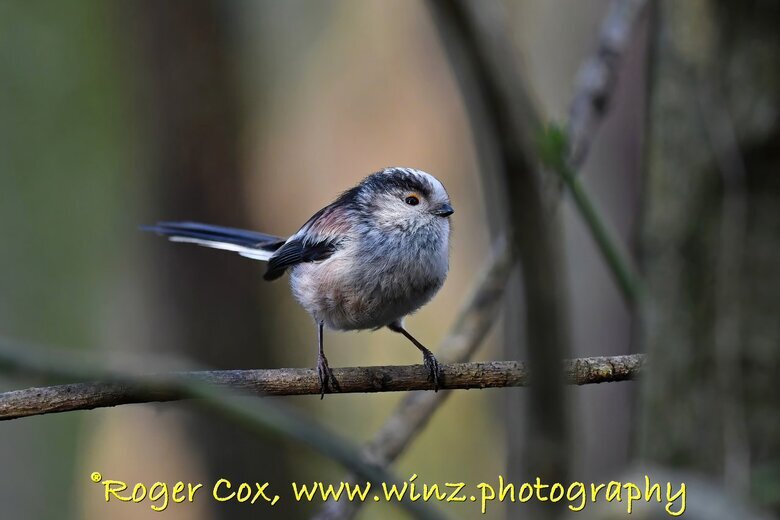
The Family by Roger Cox
Tower Hamlet Cemetery Park, Bow, London
For many animals, living in a family is key to their survival. Not only do families act as a bulwark against rivals and predators. They also make better support systems for those in distress; offer a greater degree of care for more vulnerable members, and provide a strong sense of community whenever help is needed most. One tiny exemplar of this kinship social system is this long-tailed tit, so-called because of its distinctive long tail, which exceeds its body-length, though the name is a misnomer since they're not tits, but closely related to babblers.
These exquisite little birds live and forage in extended family groups. Given the possible perils of any family outing, keeping in touch with repeating contact calls is essential. The downside is the give-away to anything within earshot interested in them as prey. But with more than enough eyes on the lookout for dangers, as well as opportunities, they succeed in ways they might otherwise find difficult if they had to live and fly solo. So, who better to huddle-up next to in the cold than a like-minded relative with similar goals and interests. Interests that go well beyond providing bodily warmth within "the bosom of one's family."
Should any relative fail to breed, they will instead aid one of their own with its nest and help rear their young. For the long-tailed tit, at least, it's a behaviour that ensures their success against the dangers and uncertainties of a life lived alone.
March 2021
"Otterly" by Roger Cox
Dartmoor Zoo, Sparkwell, Devon
Romping around along rivers and banks sounds like a pleasant enough pastime, but life, even for an animal as entertaining to watch as the Asian short-clawed otter isn't all fun and games. They do enjoy a good playtime, well into their adult years, but don't be fooled into thinking its because they're young at heart. Behind the veil of that playful cuddly-toy charm lurks a more sinister character, one with vicious behavioural tendencies deeply rooted in its family tree.
Short-clawed otters are mustelids; part of a group of carnivores whose members read like a long list of blood-thirsty killers. Relatives include stoats, minks and martens, as well the notorious wolverine and honey badger! So to see them at play in Dartmoor Zoo with that blood-lust in the guise of a spirited fun time is all the PR they need for us to overlook their ties to one of the animal kingdom's most ferocious families!
They're native to the rice paddies and streams of southern India and China, South-East Asia, Indonesia and the Philippines. As the world's smallest otter, and highly vocal at that, size sets no limit to their varying appetite for 150 different kinds of prey! However, as pups and playful adults, they're beguiling enough to seem "otterly" adorable. So, it's difficult to picture their cute little faces in such a rogue's gallery of ruthless predators. Yet predators they are, who endlessly enjoy toying with everything and each other with their powerful jaws and teeth.
February 2021
The Last Kings of Scotland by Roger Cox
Speyside, Cairngorms National Park, Scotland
On August 1st 1714, Queen Anne of Great Britain, and the last ruling monarch from The House of Stuart, died.
Titles and crowns come and go with the heads that bear them. Happily, for much of Scotland’s wildlife heritage, its royalty has remained. King, emperor and monarch stags still roam those glens and moors where the majestic golden eagle ascends to rule their skies. But if you want to see an endearing self-crowned princeling amongst such regal peers, then look no further than a Caledonian pine forest!
With its bonnie wee crown commanding such an air of pre-eminence, it’s impossible to ignore the individuality and august charm of the crested tit. A pine seed specialist and invertebrate feeder whose cup-shaped tree-hollow nests of lichen, moss and spider webs, are subject to Britain’s last domain of ancient highland conifers. Sedentary by nature, they’re scarce throughout the rest of the UK, making Scotland’s remote northern reaches their territorial stronghold.
By all appearances, a modest grey and buff coloured tit with a short black bill and bib. But it’s that family crest; black eye-stripe and bridled face pattern that sets them apart as the “Bonnie Prince Chirpy” of highland songbirds – and since they're no pretenders to that, perhaps the last and only Scottish princes whose crowns were never in any doubt. Thus, superbly remaining heirs in perpetuity to their own great houses and lands of Scots pine and oak – unlike The House of Stuart.
January 2021

The Nut Hacker by Roger Cox
The Forest of Dean, Gloucestershire
Crowd feeding isn't to every bird's liking. Some prefer solitude, while others never share. Yet many garden birds often come to terms over a well-stocked bird table, where disputes are set aside by establishing a pecking order. However, these tenuous accords held together by hunger and the need to banish it, are no defence against the chaos caused by the sudden appearance and departure of those without table manners.
In making a dashing entrance and exit to these backyard bonanzas come our best chance to see a rare garden visitor. A speedy, agile party-crasher with a penchant for scattering seeds from bird tables across the land.
This feisty blue-grey and buff coloured agitator, resembling a small woodpecker else, a cross between a blue tit and a wryneck is the nuthatch – a solitary species in the UK with more than just a talent for a dash-and-grab. Sporting a bandit mask with its small, slender bill, the nuthatch (meaning nut hacker) lives up to its name of breaking into nuts by lodging them into a crevice and pecking them open. This classic pose shows its unique ability to scale the trunks of trees head-first in any direction while searching for more seasonal fare like insects. However, when these become scarce and seeds are plentiful, their solution to the problem of winter hunger is one they're well-equipped to crack.
December 2020
The Vast Kingdom by Roger Cox
Epping Forest, Walthamstow, London
As winter approaches, forest floors become carpeted with dead leaves. Amongst the fallen foliage is a veritable feast of seeds and fruits for ground-feeding mammals and birds. But this bounty is no exclusive windfall for foraging mouths and beaks. Below ground, other lifeforms that utilise this superabundance of deciduous decay soon come to light. One of which is an organism that’s neither plant nor animal and whose actual size we’re oblivious to since all we see of it on the surface is a cap, cup, bracket, stem or ball.
These bizarre structures, known as fungi, are the fruiting bodies of an extensive underground network of branching mycelium that appear twice a year. What we know as mushrooms, toadstools, and brackets are specialised organs developed for releasing their spores. This one, the fly agaric, also produces Ibotenic acid to attract flies, quietly exploiting the beating wings of these insects as a secondary dispersal agent should it sprout in a place devoid of air currents.
Of the many outstanding facts surrounding these otherworldly organisms is how little we know about their enormous diversity, unique biochemistry and extraordinary means of conduit communication. Yet their uses in toxicology, textiles and beverages, as well as food and medicines, are indispensable, whilst their vast underground kingdom and how it governs the fate of life on Earth remains for the most part, a mystery.
November 2020
The Lesser of Sleeping Hollows by Roger Cox
Corsham, Wiltshire
One diverse group of animals comprising almost 25% of the mammals in the UK and 20% of mammals on Earth is by far the most unusual, with over 1400 species specially adapted to live diurnally in various habitats across the globe. Some eat insects. Others feed on fish, frogs, fruit, nectar and even blood! All, however, possess one remarkable ability – the power of genuine sustained flight.
Night-flying bats are masters of speed and stealth, emerging from their roosts under cover of darkness to often catch their prey mid-air by echolocation. Communicating and navigating in the dark by making ultrasonic sounds allows them to hunt undetected by most things – unless, like this lesser horseshoe bat, they happen to pass through a camera trap.
Lesser horseshoes are voracious feeders, nocturnal terrors of the insect world, sounding out their prey not with their throats but through their noses, eating almost a third of their body weight with every night-time foray! Like most bats, they give birth to a single pup each year, leaving themselves vulnerable to population crashes if disturbed during their breeding season. However, they're tenacious survivors, and when forced to live hand-to-mouth in a desperate dash for a new place to sleep or to brood their young, lesser horseshoes have an edge by staying a super-olfactory nose ahead.
October 2020

A Picture of the Adorable Grey by Roger Cox
Meath Gardens, Bow, London
In 1876, Thomas Brocklehurst returned from America and released a pair of grey squirrels onto his country estate. Soon, the novelty of importing greys as pets rapidly took off, but as interest in them waned, a growing trend of releasing them into the wild saw them well-established fifty years later.
While history presents a picture of the grey squirrel as the victim in its introduction as an alien species, its story carries little weight for any pardon it might receive for its role in the decline of our much-loved native red squirrel. For all their cute and comical charms, the grey squirrel is the Typhoid-Mary of the squirrel pox virus. A disease they’re immune to, yet one that's lethal to reds – a trait that’s made their presence in places where few reds remain unwelcome. But their persona non grata doesn't end there. Despite their significant popularity with photographers and those who enjoy feeding them in parks, their widespread success and the damage they cause as rodents have constantly maligned them as a naturalised nuisance.
In their defence, grey squirrels are intelligent expert tree-climbers. This one proved remarkably confiding, showing their more adorable side. Perhaps the only aspect of them deserving any regard we might have for their welfare, which, after all, is the least we can do for the price they now pay for those crimes against nature that brought them here in the first place.
September 2020
The Defiant Ones by Roger Cox
Walthamstow, London
Mention the word rat, and if we’re not thinking of a despicable former friend, a deceitful lover or a disloyal associate, it’s usually with a sense of alarm over an animal associated with filth, disgust and disease. Understandably, whether human or rodent, rats are creatures most of us would rather avoid.
Yet from an estimated 3.3 million streetwise rats in our *cities, it’s said we’re never more than ten feet away from one. An adage perhaps true of their human counterparts, but with more than 50% of urban rats dwelling in our sewers, it’s more like 164 feet - a distance not far enough to lessen any dislike of them.
Still, after thousands of years of living amongst us, rats have acquired a measure of intelligence and a resilience many would scarcely credit. They’re naturally curious with episodic memories and the ability to grasp concepts such as the importance of keeping a low profile when studying us as benefactors or how their deaths and injuries pertain to our methods of their control. Point of fact: in defiance of our centuries-long efforts to decimate them, there's little in the way of extinction facing the ubiquitous brown rat!
Proving themselves highly adaptable to human activities that threaten many other species has placed them firmly on top as the most successful mammal on Earth, second only to ourselves — a commendable achievement for an animal widely held in such low regard.
*within the UK; 10 ft =3 metres; (164 ft = 50 metres)
August 2020
To Bee, and Sometimes Not To Bee by David Welchman
Winchester, Hampshire
Bee orchids are special for many people, with the extraordinary bee-like appearance of the flower. This was the first one I had seen for around five years and also the first I had seen of the colour variant named belgarum which has more pale colour than usual on the lip, and was first described in 1994 in Hampshire, where I took this photograph. Five years ago, the last bee orchid I saw was on a roadside verge where three or four plants suddenly appeared, but despite searching every year in the same spot, I've not found it again. This variation in numbers is a well recognised feature of bee orchids - plants may not be seen for several years although in other sites it may be more regular. Bee orchids are mainly found on limey soils in the southeastern half of England but can occasionally occur on different soils and in other parts of the country. I hope it won't be as long as five years until I see my next one!
July 2020
Hidden In Plain Sight by Roger Cox
Hastings Country Park, Fairlight, East Sussex
Look closely enough at any patch of long-preserved grassland, woodland or heath, and you might spot a small, scaly, cold-blooded predator. One wholly reliant on the sun's warmth for its next meal and the means to avoid becoming the same thing for something else just as hungry.
As its name suggests, the common lizard is the UK's most widespread reptile. It's also our most unusual, possessing the extraordinary ability to incubate its eggs inside of its body and giving birth to live young. By hatching inside a womb, they're born to a sheltered life, hence naturally reluctant to spend time in the open - unless driven to do so. Should they find themselves under attack or trapped, they can shed their tails to quickly escape.
They frequently favour the warm spots; sneaking out from the undergrowth to covet familiar places to bask. This one, hidden in plain sight on a cut down tree trunk, was typically situated for a lightning-quick retreat into dense cover at the first sign of danger. However, it was the sight of my camera, causing it to disappear time and again that had me stumped! After several attempts (bracken and bramble notwithstanding), it did eventually settle beneath those fronds and blackberries, allowing me at least to enjoy the sight of some fruit to my photographic labours.
June 2020
Of Wood Mice and Men by Roger Cox
Tower Hamlets Cemetery Park
Graveyards at night can be unsettling places, and yet some animals do well to inhabit them, relying on their eerie darkness and a healthy human respect of the dead so as not to be intruded upon. One such resident of Tower Hamlets Cemetery Park is this wood mouse; captured unnervingly one evening by said photographer stupid enough to set-up over a disused grave in a place where even fools feared to tread.
They’re agile climbers, and when foraging, frequently mark their territories with twigs and leaves. However, as prolific breeders, they’re not so restricted to a life in the sticks; being equally at home on dunes and moorland, as well as gardens and houses, where they inevitably encounter their most significant threats – cats and traps. Yet despite a long list of natural enemies, it’s only in habitats as silent as the grave are they able to forage with impunity throughout the dead of night.
After two hours of gathering seeds and nuts, this one decided to end its graveyard shift by disappearing back into its bolt-hole. Leaving me alone in the dark, with the creepy sound of things moving amongst the dead, and the morbid fear of my visit to this particular cemetery ending in a more permanent stay. Not a venture I’d care to repeat — the best-laid plans of mice and photographers, you understand, and a bad case of nerves to boot.
May 2020
Cousins by Roger Cox
Thrigby Hall Wildlife Gardens, Great Yarmouth, Norfolk
Long before domestic cats became celebrities of film, theatre, TV and the internet, they lived in forests and jungles like their wild relatives today. Sadly, and for the same reasons, some of the smaller lesser-known wild ones have found themselves in zoos and sanctuaries alongside their more prominent great cousins. As is the case with this Asian leopard cat; seen here sinking its teeth and claws into a hen-house dinner at Thrigby Hall Wildlife Gardens.
Similar to a house cat in size and appearance, you might think this a picture of a hungry feral tabby that had found its way into a chicken coup! A misapprehension, perhaps, and yet one closer to the truth than you might realise. In South East Asia they're sometimes kept as pets, but because of their wild nature are often bred with domestic cats to produce more friendly hybrids like the Bengal cat or Siamese flame point. So who knows? Perhaps that social media superstar purring on your lap, or asleep in its basket under your bed could well be harbouring one or two inherent traits of a particular cousin once removed. With such a pedigree of predatory instincts, it might surprise you that what's often taken for playful entertainment is, in fact, a behaviour all too eager to savagely claw its way back into that forest or jungle whence it came.
April 2020
The Charm of Hummingbirds by David Welchman
Esquinas Forest Lodge, Parque Nacional Piedras Blancas
I was fortunate to be able to visit Costa Rica in January. It is a country with an amazing diversity of wildlife and I was especially looking forward to seeing hummingbirds. According to my ''Birds of Costa Rica' there are fifty species in the country, of which we managed to see around fifteen. Gardens are the easiest places to see them, where they can feed from garden flowers and are easier to photograph. I also learnt that they have favourite perches, where they return every few minutes between feeding.
This Charming Hummingbird had a particular favourite spot and was quite approachable. It is a native of Costa Rica and nearby Panama and is one of the hummingbird species where the males form small leks at the edge of the forest, to attract females. This garden was in a lovely setting, surrounded by unspoilt forest forming part of a National Park, and was home to a great range of birds as well as other wildlife.
March 2020
With A Smile On Her Face by Roger Cox
The Crouch Estuary, Essex
In high summer at low tide, some of the more secluded places along our coastlines become hauling sites for us to catch sight of a marine animal that’s a different kettle of fish. Though often pictured swimming around rocks and floundering on mud-banks, it undoubtedly is not a fish. However, should we compare it to an actual fish kettle, a single adult could well hold up to a ton of fish a day!
Swimming against the tide with a weight up to 145 kg, female harbour seals gather on some of the least accessible parts of our shores to claim their favourite haul-outs to pup. An arduous task, not only for their fittest swimmers but the hardiest of mothers, as they battle the prostrating effects of some of the most challenging terrains all for the safety of their young.
Beneath the waves, seals are as agile and as streamlined as their prey. On land, however, they're very much the proverbial fish out of water, vulnerable to heatstroke and dehydration thanks to their thick insulating blubber and the constant release of a salving fluid around their eyes.
Since soon-to-be mums neither eat nor drink until their pups are born, it’s that lachrymal look of hunger and helplessness that we empathise with most. So it was nice to capture this one, cooling herself on the grassy banks of the River Crouch, not so much with “tears” in her eyes, but with a “smile” on her face while anxiously awaiting her happy event.
February 2020
True Love's Kiss by Roger Cox
Lawrence Green Close, Bow, London
February — a time for crocuses, snowdrops and daffodils. It's also a time when a feral pigeon’s fancy quickly turns to love. Or so you might think from this wedding-style portrait of these two lovebirds taken on a local housing estate in East London. So, what better time than the month of St Valentine's to muse on Cupid’s arrow piercing the hearts of some of our feathered friends too?
Many species mate for life; doves, parrots, and swans are the easiest to cite amongst birds, but kissing, as in that ultimate, intimate act of lip-to-lip service we pay another as an expression of love, is rare in the animal kingdom. Primarily, it’s a human thing, and yet, with over half a million pairs in Britain breeding at least six times a year, it’s a pigeon thing too! But before we fly off with any lovey-dovey St Valentine's Day notions of what a pigeon's love life has come to represent, the truth is that for this courting couple, true love’s kiss is no clean, quick thrill. When pigeons consent to mate, the male passes food from his crop to the female, who accepts by eating it. It’s a bit like someone spewing into your mouth during a French kiss. Though in our case, as well as swapping eighty million germs worth of saliva, there's an appetiser that comes with it too! True love indeed, if you can stomach it long enough to keep the romance going.
January 2020
Generations by Roger Cox
Burrator, Dartmoor National Park, Devon
Everyone loves a baby and babies demand attention, even those of the equine variety. Yet as much as babies need attention, they also need the one thing good parenting always provides but can never guarantee – a secure and promising future.
For the Dartmoor pony (not to be confused with the Dartmoor Hill pony) it once seemed as though that future was in doubt. With approximately five hundred left, there are now fewer indigenous purebred ponies roaming the moors than giant pandas in the wild! It’s an old story, echoing the fate of millions of endangered species around the world, unless something is urgently done to ensure their survival.
Being hard to come by in the Burrator region, made meeting this friendly youngster a rare treat. Well worth the long trek and the short time it took to photograph it. Happily, for Devon’s oldest breed of semi-wild horse, the finish line in their race towards extinction is no longer in sight.
Thanks to the work of committed individuals, measures are now in place to preserve their six-thousand-year-old lineage. So that frolicking foals like this one will not only continue to play a vital role in the ecology and economy of Dartmoor, but hold a special place in the affections of grateful nature lovers like me for generations to come.
December 2019
City-dwellers by Roger Cox
Bow, London
There is an animal so adept at making the most of its terrain that it can thrive almost anywhere. Be it a desert, tundra, peat bog, sea cliff or a busy town centre. Its remarkable aptitude for survival under such a wide range of conditions stems from its variable diet, along with the skills it possesses to forage and hunt, which is why, of all the mammals that have learned to cope with our continued development of the world, none have proven more resourceful than the red fox.
So widespread has it become throughout our cities and suburbs that its distribution and range now includes those of humans and rats, thanks to its unique ability to take advantage of both.
Foxes are innately wary of people, making them elusive and challenging to approach. However, much like photographers, they rely on opportunism and in large, urban communities will often familiarise themselves with people and places in exchange for an easy meal — a behaviour cultivated by our love or indifference towards their cunning and mystique. Hence, as charming scavengers or devious predators, willingly or unwittingly, many households in Britain feed foxes, and although the attention they pay to our bin stores, pet rabbits and guinea pigs is far from welcome, I still find it exciting to see something of their wild presence skulking about the urban landscape — a genuine treat, for wildlife-deprived city-dwellers like me.
November 2019
The Fisher-King by Roger Cox
Otterbourne, Winchester
If you've ever walked alongside a quiet, slow-flowing river and were suddenly surprised by a bolt out of the blue that was indeed blue, then no doubt you've experienced the typical sighting of a kingfisher.
With hummingbird-like speed, a dashing flash of electric blue is all we often see of them — unless you're fortunate enough to discover one of their perching places and prepared to sit and wait.
To see one diving from a branch, plunging head-first to merge with a splash of water, only to surface with a fish in its bill is riveting. They need to eat 60% of their body weight a day! A requisite that has driven them to an aggressively territorial and solitary lifestyle. Hence for these colourful freshwater "gannets", prime perches equate to prize catches. So, places in which they can meet their quota of at least eight fish a day are not only eagerly sought, but all the more guarded.
Since their survival depends on a branch overhanging a suitable body of water, disputes with neighbours can be as contentious as a game of King of the Hill, or as savage as a Game of Thrones. Battle royals between them can even go as far as to see a rival knock an opponent into the water, seize them by the bill and try to drown them, with the victor emerging to a crowning moment by taking their place on that perch as the king of fishers indeed.
October 2019
A Shot Called Wonder by Roger Cox
Epping Forest, Walthamstow, London
Nature is full of wonders, many of which we never see. Some, however, stay hidden while others, regarded as commonplace, are taken for granted. Yet special moments occur throughout the natural world every day and in plain sight.
So you might think that with 3.6 million blue tits in Britain they’d be little chance of finding anything extraordinary about them, and yet the blue tit is one of six non-migratory British birds* to have blue in its plumage, and then only one of three with a blue tail, wings and cap! A distinction uncommon enough to see why many of us find their beautiful mixture of blue, white, yellow and green so fascinating.
When airborne, out in the open, wings beating within the blink of an eye, a few short bursts of undulating flight is all we see of them, and yet there’s more to them than meets the eye. They’re remarkably aerobatic, executing tumbles, twists and turns on every approach to a smart landing - a surprising feat for such a small bird with a stocky body and one that can only be appreciated using high-speed video or photography.
It’s startling that for 1/3200th of a second, we can see one of nature’s wonders revealed along a journey that’s taking us generations to discover them! Though how many incredible moments (and shots) like this I miss every day is still a mystery, if not a wonder.
*Mallard, magpie, jay, nuthatch and kingfisher are the only other resident UK birds with blue in their plumage.
September 2019
Summer Golden Plover by David Welchman
Moor House, Upper Teesdale National Nature Reserve, County Durham
I visited Upper Teesdale in March and was delighted to see golden plover in their winter plumage feeding with lapwings on some of the fields not too far from the river. I returned in June and visited the National Nature Reserve itself, a unique area for a wide range of wildlife. I was walking along the footpath and heard melancholic piping, as I have read it described, which I thought must be golden plover. Shortly afterwards I saw a pair close to the footpath. This bird was moving through the coarse grasses, stopping every so often on a slight elevation perhaps to get a better view of me, and I was particularly pleased to get this photo as it stood warily on a hummock of moss, which perfectly matched the colour of the feathers on the bird's back.
August 2019
Hark, Hark, the Car Park, Lark by Roger Cox
Jennycliff Car Park, Plymouth, Devon
Whether “aloft on turf or perch or poor low stage[1],” no bird has been celebrated more for its enthusiasm in singing than the skylark. Its repertoire of intricate melodies is an integral part to the seasonal soundtrack to heaths, moors, farmland and coastal habitats — even those with car parks.
Being widespread in rural areas, and one of the few birds there to be heard all year round, they truly are a quintessential feature of the countryside. Throughout spring and summer, males can be seen singing and ascending almost vertically to a great height before making a drop-and-stop descent in full song towards the ground. A spectacle that for centuries has captivated poets, artists, authors, and more recently, film-makers and photographers.
Whatever our fascination with the lark, it appears to be a highly imaginative, if not, romantic one. Perhaps it’s the angelic-way they exalt themselves that makes their “summoning[2]” back to earth a classic case of poetry in motion. However, capturing this one with its feet firmly on the ground proved no less sublime for both bird and photographer. For one, a closer opportunity to listen to that famously idyllic song, and for the other, a brief but immense relief from the pressures of airborne survival over a busy coastal car park.
[1] The Caged Skylark by Gerard Manley Hopkins (1844–89)
[2] From The Skylark by Richard Watson Dixon
July 2019
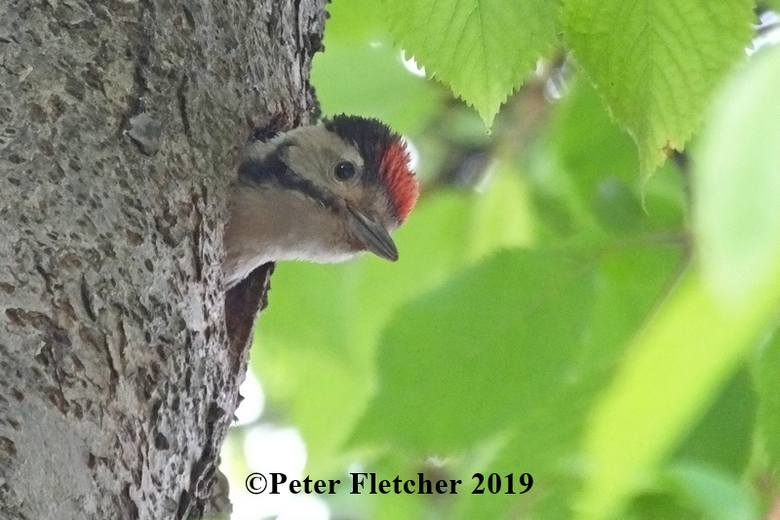
Well-Spotted by Peter Fletcher
Edmonton, London
As I was walking to some local shops near the Galliards Estate, I heard a chick calling from one of the lime trees by Jubilee Park, at first I looked and looked, but couldn’t tell from where the sound was coming.
On my way back, I stopped to look and listen again; only this time, I saw a greater spotted woodpecker on the same tree near a nest hole feeding its young. “That’s it!” I thought, “that had to be it.” After the adult bird flew away, this single youngster (on the verge of fledging) poked its head out from the hole, only to see me looking up at it - a surprise to us both!
I watched and waited for a while as its parents made frequent visits with food, sometimes to feed it and at other times to encourage it to leave the nest. It was almost as though the chick kept saying, “great, time to eat!” and the parents, “no, its time to fledge.” Talk about luck and fun rolled into one. As things looked to stay that way for some time, I dashed home to fetch the camera. When I returned, I managed to take several pictures of the chick looking out for more food.
On the whole, you could say it was a shot of a well-spotted greater spotted woodpecker that was too good to miss!
June 2019
The Call of the Curlew by Roger Cox
Stanpit Marsh, Christchurch, Dorset
There’s no sound more telling about the wildlife in a marshland than the call of a curlew. Whenever severe weather subdues that life into silence, curlews are one of the few birds to be heard through the mist over its moors; its windswept reeds, or out on those icy mudflat feeding grounds. It’s a call that’s as distinctive as the curve of its beak, and yet, at a standing height of fifty centimetres, curlews can be difficult to spot. Against a reed bed or wet grassland, they’re practically invisible until they audibly give themselves away, else step out or fly out into the open.
In waiting for this one to appear from the other side of a mound, I had hoped it would herald its appearance with that unmistakable call, but alas, nothing so dramatic. Instead, it quietly came into view, only to pick up on my presence, and then famously disappear again.
Sadly, that evocative call so inextricably linked to our wetlands is now in decline. Marshes are beautiful, but dangerous places; vulnerable to pollution and climate change. So, could the inaccessibility of their terrain be hiding a peril from them as much as their excellent camouflage does for them with everything else? So far, all we've managed to ascertain is that across the UK and Ireland curlew numbers are plummeting, and that their once familiar haunting call, has become our wake-up call to the alarming possibility that the next time we happen to see one disappearing into the reeds, it could well do so forever.
May 2019
Let Sleepy Hogs Lie by Roger Cox
“If you go down to the woods today, you’re sure of a pig surprise!” For roaming the forests, moors and cornfields throughout the shires of our green and pleasant land is a controversial wild pig that hasn’t lived here since it became extinct four centuries ago.
The Eurasian wild boar may not be the most lovable of our few remaining large mammals. After a long, but short lamented absence, it wasn't altogether missed. However, since its unofficial reintroduction two decades ago, it has settled in well enough to become a keystone species for woodland ecology. The only downside to its importance there is the trouble it’s causing everywhere else!
Pigs are driven by their stomachs and led by their highly efficient noses; a porcine characteristic that never ends well when a seventeen stone hog like our friend here picks up on the scent of a freshly mowed playing field or maize crop should anyone be foolish enough to get in their way! Being notoriously unpredictable, even this docile zoo friendly exhibit could unintentionally injure a keeper withdrawing its feed bucket! Fortunately, this one at the NFWP chose to appear more bored than to be boorish, but its caprices were still a threat to consider while crouched two metres away from such a commanding bulk of solid muscle and hair. A concern I might add, with enough weight behind it for me to back away slowly when finished, and think twice about not letting a sleepy hog lie.
April 2019
White Spring and Black Thorn by David Welchman
Itchen Abbas, Winchester, Hampshire
Blackthorn is the first of the hedgerow shrubs to flower with an abundance of white blossom in late March and early April before the leaves appear. I took this photo on the 28th March during a mild spell of weather, although tradition has it that it can turn cold whenever blackthorn is in flower, the so-called 'blackthorn winter' effect, but who knows? There may be colder weather to come. Whatever the weather, a beautiful show of its spring blossom is a sign of a good crop of fruit in the autumn - sloes, which have a bitter, astringent taste when eaten raw. They were once used as an ingredient added to brandy to make imitation port. Today they’re used to make sloe gin.
In this picture I wanted to show the white spring flower with its many stamens and also the base of the thorn at the top, to give an overall semi-abstract appearance. The blackthorn's English name and scientific name, Prunus spinosa both refer to its very strong, sharp thorns which can make picking sloes in the autumn a painful task!
In winter and early spring, the blackthorn branches at this location are often a mass of yellow and pale grey due to an abundant growth of lichens, which seem to favour blackthorns more than any other tree or bush, something I've noticed in other places too — clearly a shrub with an all-year-round attractiveness for the nature photographer.
March 2019
Cold Comfort Charm by Roger Cox
The Lake District Wildlife Park, Keswick, Cumbria
Imagine being stuck inside a cold, cramped house with no heating your entire life. Now imagine someone else with the same problem enjoying the comforting warmth of their home by denying you the pleasure of enjoying yours. Worse yet, having to suffer that person not only as a bad neighbour, but as a bullying housemate.
Selfishness, dominance and violence are characteristic of the possessive, oppressive and aggressive, which is somewhat fitting for the cold-blooded nature of the African spurred tortoise. Males are far from sociable; constantly given to barging, biting, ramming and overturning rivals when it comes to food, a mate, or in this case the best place to bask under a 250 Watt bulb! Females (when not pregnant) are better behaved, but as with the rest of their kind, strangers to any notion of caring. So that even for the smallest member of this trio at The Lake District Wildlife Park, figurative terms like “being sat on" and "hogging the heat," have a more literal meaning when it comes to sharing some of the warmest places with the coldest of companions. That said, spurred tortoises aren't all bad. They can be docile, shy and quiet as well as long-lived, which only adds to their charm when the biggest ones amongst them are not only stealing the limelight, but all the heat from it as well.
February 2019
Fieldfare and Hawthorn Berries by David Welchman
Itchen Abbas, Winchester
There was a great crop of hawthorn berries in the autumn, and the hedges were laden with them. On 8th November I saw the first fieldfares of the season, and they were soon feeding on the berries in this hedge, alongside blackbirds and the occasional redwing. There were up to seventy fieldfares in the area, and perhaps ten visited this hedge at any one time. In three weeks the berries were gone, the hedge stripped bare. Within a short time, the berries in the nearby hedges were also gone. The fieldfares are still around the area, several weeks later, but not in such large numbers, and they must have to work much harder for their food now that the berry feast has gone.
January 2019
A Happy New Deer by Roger Cox
The Knole Deer Park, Sevenoaks, Kent
As the New Year begins, those of us who are still healthy and active naturally have expectations of better things to come. Fresh hopes in January often begin with our boisterous enthusiasm being carried on a wind of change in the hope that the next twelve months will be more fulfilling than the last.
It’s easy to compare our own bounding sense of optimism for a promising start with that of a frolicking fawn eager to explore the world as quickly as its young legs can carry it, but what we perceive as mere play in the early life of such an animal, is really a series of baby steps towards developing an ability every deer needs if it's to grow up quickly, or not grow up at all, and that's the ability to run!
The life of a young deer in the wild is precarious at best, and as if to turn a well-known maxim on its head, a fawn’s survival not only hinges on it being "of the fittest," but also, of the fortunate. Newborns must either stay hidden else run a gauntlet of dangers from bears, wolves and lynxes with perils further afield from traffic, poachers and hunters. Which is why I was delighted to capture this herd of young fallow deer in the sanctuary of The Knole taking to their hooves predator free! Whatever triggered their flight had one yearling above all keen to keep going. A promising start, for a happy new deer.
Is wildlife or nature photography something you’re passionate about? If you have a story to tell with a stand-out picture you’d like to share, we've plenty of wall space here in our gallery.
